![An “Ode To Matisse” Quilt]()
by Ariane Zurcher | Feb 26, 2017 | creative process, Design, Free Motion Quilting |
Last fall I decided to design my own bed-sized quilt. I wanted a quilt that would remind me of spring and summer, that was colorful and had big organic shapes that inspired cheerfulness. This was before the election and though there were many things being said that were ominous – calls for great walls to be built, mass deportations being touted as campaign “promises”, comments about bringing back the “good old days”, leading many of us to wonder to whom those “good old days” applied, (obviously not women, minorities, and anyone who didn’t conform to traditional gender roles and relationships) all this from a man dogged by bankruptcy, lawsuits, accusations of fraud and sexual misconduct, a man who bragged about assaulting women, not paying his taxes, and encouraged his supporters to physically assault those who voiced opposition to him – still, it seemed there was room for optimism, and, if nothing else, the elections hadn’t taken place yet. Those months and weeks before the election now feel like the “good old days”.
So in the midst of all that, I decided to design my own quilt and was inspired by the shapes in a fabric covering a chair and couch my husband used to have in his office at his advertising agency, that now occupies the western portion of our bedroom.

Couch in our bedroom
I wrote about this quilt, that I began designing and intended to make, just after I’d chosen all the fabrics for it. I discussed the process of taking a sketch and translating it into an actual quilt. That post is ‘here‘.
Matisse reminds me of the playfulness that can be a part of life if we allow it in and the shapes he created make me smile. The colors he frequently used tended toward bright, primary colors, and I decided to stay close to those as well. It took ages to figure out where everything would go, what fabrics to use, how to fit everything in to the size quilt I knew I wanted. The quilt kept getting bigger, and even though it is intended for a twin bed, I wanted it to be long enough that I could tuck it under and over pillows. I really wanted it to be the size of a bedspread.
And then the elections took place and I threw myself furiously into escaping what was now to become our collective reality learning how to dye my own fabrics. I took several classes at the Academy of Quilting taught by the extremely, talented, artist Elizabeth Barton. Between learning to dye, which I love, love, LOVE, playing with colors, and sporadically working on my “Ode to Matisse” quilt I managed to avoid getting too depressed by the events and endless drama that has now become commonplace with this new administration. Still, I knew I’d have to make a concerted effort to concentrate on my Matisse quilt if I was ever going to finish it. So about a month ago I began working on it daily. The free motion quilting, which I’m very new to, was challenging and I ran into lots of tension issues, but then went back to one of the dozens of Craftsy classes I have enrolled in and was reminded not to be afraid to turn the tension down as far as needed in order to get the threads to behave with each other, no matter how imbalanced that relationship might seem. Read whatever you like into THAT statement, but it did seem ironic given who now occupies our White House.
There are many wonderful free motion quilting classes on Craftsy, but the two I particularly love are Free Motion Quilting Essentials taught by Christina Carneli, her blog is A Few Scraps and Divide and Conquer: Creative Quilting for any Space taught by Lori Kennedy, who also has a blog, Inbox Jaunt. They are both wonderful. Christina also teaches several other free motion quilting classes for those who are more experienced. But for me, starting out with her class was perfect and just what I needed to attempt this: 
and this: and this…
and this… And this…
And this…
From Lori’s class I began with doodles of things I saw others doing and then took it to the quilt. Patterns like this… and this…
and this… and this…
and this… With each block, I tried a different free motion quilting pattern that I thought complimented the shape in the block. I know many feel the shapes themselves should also be quilted and I may have to go back and quilt the larger shapes, but I wanted them to pop, so decided to leave them alone. Once all the blocks were quilted I agonized over the binding. Eventually I opted for the darkest background beige fabric I had used. I cut it on the bias, pieced it together and then following the instructions in Mimi Dietrich’s book, Happy Endings I bound the whole quilt with mitered corners. I added a label and voila!
With each block, I tried a different free motion quilting pattern that I thought complimented the shape in the block. I know many feel the shapes themselves should also be quilted and I may have to go back and quilt the larger shapes, but I wanted them to pop, so decided to leave them alone. Once all the blocks were quilted I agonized over the binding. Eventually I opted for the darkest background beige fabric I had used. I cut it on the bias, pieced it together and then following the instructions in Mimi Dietrich’s book, Happy Endings I bound the whole quilt with mitered corners. I added a label and voila!
And here’s a shot of the label

There’s nothing quite as satisfying as finishing such a mammoth project, except of course writing about it while it is draped over your lap!
I forgot to include the contents of this quilt on the label. They are: 100% cotton fabric, Wool Batting, Cotton thread.
Next up – my Block of the Month quilt that I’m currently designing and working on, inspired by the fabulous Sue Spargo, who is to blame for my current obsession with all things fabric, quilted, embroidered, embellished, etc.
![An “Ode To Matisse” Quilt]()
by Ariane Zurcher | Dec 16, 2016 | Art, creative process, Dyeing |
Fabric painting was something I knew nothing about before taking Elizabeth Barton‘s online class Dyeing to Design at the Academy of Quilting. Fabric painting is the process of combining fabric dye with a thickener so it can be used to paint fabric, just as one would paint on a canvas. Think about that. The possibilities are endless!! As we had been silk screening the week before, I used a couple of my silk screened fabrics and painted on them and then decided to branch out and paint on a blank white piece of cloth. Here are some of my doodles.
As you can see I had fun! I also painted the fabric in the photograph below, but I didn’t have a clear idea of what to do with any of it. While painting the fabric in this photo below I was thinking about how we are all moving along in our lives, sometimes following, at other times leading, sometimes crossing paths with others, but can often feel we are alone even though we live in a world populated by so many. Still, if we can just remember to reach out to others, we find our experiences are shared by many. Should I have just written all that in the first person singular? But then I might have felt that alone feeling again… Anyway, I sat with these various fabrics and did nothing for several days.
 Then, having given up on the idea that I was going to be miraculously hit with a blast of inspiration, I cut up the fabric (just a little, nothing radical) and sewed it back together (photo below.) And then I sent it off to my class for feedback, that’s the whole reaching out thing that I mentioned above… Elizabeth is an excellent teacher and can be depended upon to make terrific suggestions.
Then, having given up on the idea that I was going to be miraculously hit with a blast of inspiration, I cut up the fabric (just a little, nothing radical) and sewed it back together (photo below.) And then I sent it off to my class for feedback, that’s the whole reaching out thing that I mentioned above… Elizabeth is an excellent teacher and can be depended upon to make terrific suggestions.  Which led to this…
Which led to this… And this…
And this… And this…
And this…
And finally, finally, finally… this… Which became this… traveling along our various paths…
Which became this… traveling along our various paths… And finally, this… reaching out to others and no longer feeling so alone…
And finally, this… reaching out to others and no longer feeling so alone… Here are a few close ups of the machine and hand stitching…
Here are a few close ups of the machine and hand stitching…






And this is the back.
Traveling Together measures 21.75″ x 21.75″ All the fabric was hand painted and hand dyed. Then quilted using a cotton batting and kona cotton back. I did the hand stitching using a perle cotton thread as well as a wool thread. The binding was hand dyed and sewn on, as was the label.
I still have not figured out what to do with my various silk screens, but I just finished painting over a few of them and plan to over dye a couple of others, so will see what the results are after that. In the meantime I painted a few more half yard pieces of fabric and am eager to see how they turn out.
Elizabeth’s Dyeing to Design class is over, but she’ll be teaching it again in the spring, I believe. I cannot recommend it more highly.
![An “Ode To Matisse” Quilt]()
by Ariane Zurcher | Dec 8, 2016 | Art, creative process, Dyeing |
I was going to entitle this post Fear of Dyeing (and Silk Screening) but Where’s the Pun in That? But it was too long so I just went with the edited version… a girl can have a little pun. Okay, okay that’s enough. I’ve filled my quota of puns and I’m barely out of the starting gate. It’s all going to be very serious from here on out.
In my last post I promised screen printing, so here we go. All the photographs below are of techniques described by Elizabeth Barton in her wonderful class Dyeing to Design over at the Academy of Quilting.
The last and only time I did screen printing was when I worked (briefly) for the fashion designer Zandra Rhodes while living in London having just graduated from Parsons School of Design about a hundred years ago. Zandra Rhodes is known for her beautiful silk screened fabrics as well as being the “Queen of Punk” a distinction given to her back in the late 70’s. All I remember from that time, aside from the time she told me to clean her bathroom, was using a huge squeegee-like thing to scrape paint across the enormous screens she used. I wish I could remember more as it might have helped me get over my fear when tackling Elizabeth’s silk screening lesson. I have to admit I was completely intimidated reading the lesson over, so much so that I read the lesson and then didn’t do any of the exercises mapped out in it for at least three days. Then another person in the class posted her gorgeous silk screened fabrics and it motivated me to at least try some of the techniques suggested.

Using newsprint this was my first attempt at silk screening on white cotton
Have I talked about fear during the creative process? I know, I know, I have. But maybe you didn’t read that post and anyway, I’m feeling compelled. I’m always surprised when I feel fear while designing or doing something art “worthy”. Why feel frightened when creating something? Why should I feel anything but joy? How does fear, even a twinge of it, make itself known through all the curiosity and excitement? And while I don’t have complete answers for these questions, I do know it isn’t unusual for artists to feel tremendous fear when creating. So much so that there’s even a terrific book written on this very subject called Art & Fear ~ Observations On The Perils (and Rewards) of Artmaking by David Bayles & Ted Orland. Heading up the chapter entitled: The Academic World is this quote from Howard Ikemoto –
“When my daughter was about seven years old, she asked me one day what I did at work. I told her I worked at the college – that my job was to teach people how to draw.
She stared back at me, incredulous, and said, “You mean they forget?”
I went to Parsons School of Design for my undergraduate degree and majored in Fashion Design. Much of what I learned had to do with the business of fashion design and that there’s no such thing as new, that everything is recycled and that in order to succeed one must be as determined, if not more, about the business as one is about creating. The truth is, I learned little about being an artist and more about the challenges of being a designer in the business world. By my last year my fairy tale notion of what it would be like to be a fashion designer was thoroughly squashed and in my disillusioned state I felt only dread at the idea that I was about to go out into the world and seek a job, much less in the fashion world. After floundering for a few years I abandoned fashion design in favor of a series of jobs/careers that I thought might be more fulfilling and less soul wrenching. And while all the things I tried my hand at varied, even dramatically, they were all in the “Arts” of some kind. What I’ve learned is that artists tend to have a difficult time making a living with their art, no matter what the medium is.
There’s a wonderful quote from Oscar Wilde that begins Part II of the book Art & Fear.
“When bankers get together for dinner, they discuss Art. When artists get together for dinner, they discuss money.”
How does one price one’s art, something that might have taken hundreds of hours to create through trial and error, through missteps, through experimentation, through FEAR? If artists used an hourly wage system to price their work, all art would be so expensive no one could afford it. So most of us don’t. We can’t. And while in an ideal world no one would have to concern themselves with making money from their art, and instead would just spend all their time making it, few live in such a privileged world. The fear of being able to sell our work, and how that inhibits the process is a whole other topic and one most of us can understand, but there is another fear that is far more complicated. It is the fear one feels when confronted with something new, something one has never done before, but would like to learn. There is the fear of failure or appearing incapable or of ridicule, criticism or being seen as incompetent by others, but also by oneself. To create art, is to be at once vulnerable and confident, and it is a tricky balancing act to not lean more one way or the other. Both carry their own pitfalls.
Creating is a messy process. Most people never see all the discarded bits, the beginnings and first steps taken to get to that finished piece. What I love about blogs is that people are willing to show their process. My favorite blogs, in fact, are the ones that do just that.

Adding color to the purple
When I am starting something new I often have an idea in my head. What I envision is always spectacular, but creating that idea takes skill, talent and knowledge, things I do not always have. So I have to learn, practice, and explore in order to be able to get the skills to (hopefully) produce the image I envision. Sometimes I’m successful, but more often I’m not. Sometimes I realize it will take me years to achieve the level of expertise required to make what I envisioned. So I have to accept that I won’t be able to do something as I’d hoped or modify what I’m doing to compensate or continue to practice, with the idea that eventually I might be able to produce what is in my mind.

Torn newsprint

For this piece I cut stencils out of a thin plastic sheet, before silk screening on top

This is the result of using those stencils that I removed for the red piece above

A technique attributed to Kerr Grabowski. This piece has yet to be washed, so who knows what it will look like!

Another technique described in Elizabeth’s class.
Regardless of the approach I take, perfectionism is truly the greatest kill joy and, for me anyway, the root from which almost all my fear springs. While some argue that without perfectionism, we would settle for less or not work as hard, they are misunderstanding perfectionism at its most destructive. I am referring to perfectionism that lacerates, the kind of self-talk that abuses and brutalizes. It is that awful voice that needs to be muted before anything can be created. Free from perfectionism I am allowed to explore and play.
I have no idea what I’m going to do with any of the fabric I’ve silk screened, and in some ways that’s beside the point. I didn’t approach this lesson with a preconceived idea. And that’s the beauty of taking a class like this one. The assignments require you to explore and play first and then after you’ve done that, consider what you’ll make. Most of these fabrics have been done for almost two weeks now and I still don’t know what to do with any of them. Or as one of the many talented and wonderful people taking this class said, “I’m waiting for divine inspiration.”
![An “Ode To Matisse” Quilt]()
by Ariane Zurcher | Feb 11, 2015 | Art, crafts |
Last May we pulled our daughter, Emma from school and began homeschooling or non-schooling or… I’ve written more about all of this on the other blog, the one I share with my daughter: Emma’s Hope Book. One of the many benefits of homeschooling, aside from the huge relief and plummeting stress level, is that we get to explore, together and separately. The beauty in exploring is that the goal is to be curious and discover. There’s no right or wrong and there’s tremendous comfort in that. The entire process of learning becomes one of joy and experimentation without the burden or stress of feeling one should know something before having learned it.
So it was, some eight months ago when I sat down with Emma and asked her what she was interested in learning about. She typed that she wanted to learn German and take a ceramics class among a number of other things. So we bought Rosetta Stone for German and Emma began taking pottery lessons at a nearby ceramics studio. Her teacher, seeing my obvious excitement and interest, asked if I might like to make some things too. I eagerly said, “Yes, please!”
Learning anything new is full of experimenting, exploring, tweaking, practicing and refining techniques learned. To dive into something you’ve never done before can be daunting, but only if you are comparing your work to another’s. Particularly crushing is if you expect you will be able to produce something that is of similar expertise as someone who has been studying and refining their technique for decades. The exhilaration comes with the process of learning, practicing and improving. But so often we are not taught that this process is wonderful at all. In fact, we are taught that it is hard work and the end product, only produced after years of practice and toil, is all that is of value. Everything else pales in comparison.
I disagree.
This cereal bowl that Emma made for me is perfect for walking while eating. It has an indentation that perfectly fits one’s thumb while cupping the bowl in your palm. Why hasn’t anyone designed a bowl like this? I’ve never seen one before, but oh, how I love it. This is my new, favorite bowl.

My favorite cereal bowl made for me by Emma.
The platter below? “It matches” was what Emma typed in reply to my exclamation that I thought it perfect for serving cheese and crackers or maybe a brioche en croute with fresh baguette.

Emma’s Platter
This bowl that Emma made used cookie cutters and then she painted after joining all the shapes.

An Autumnal Bowl
A few months ago, or maybe it was years, (this is an aspect of getting older, the years feel like months, yet another example of that saying people tell you when you first become a parent – the days are long, the years are short) I asked Emma if she had any interest in learning to knit. She said she did, and as I love knitting (I wrote about some of that “here“) and used to design knitwear, I thought we’d start with something simple, like a scarf. Emma chose a light blue yarn. After a couple of tries, she lost interest and so I began making a long scarf using an alternating knit 2, purl 2 pattern. I rarely use knitting patterns or cooking recipes for that matter, but that’s another post. Anyway the scarf began like this.

Light blue scarf in alternating Knit 2, Purl 2 pattern with the beginning of a navy blue chenille infinity scarf in the background.
The finished scarf ended up measuring 87 inches in length and 11 inches wide. What you don’t see is the other side where I changed my mind after an inch or so and decided to make the pattern more elongated.

The Finished Scarf
This is the edge where I began knitting and decided to change the stitch. Three times. The final stitch pattern is a Knit 2, Purl 2 for three rows and then Purl 2, Knit 2 for 3 rows and repeating for the remainder of the scarf.

The I-Changed-My-Mind-Edge
I’m hoping Emma will try knitting again sometime, but in the meantime, I’ve started a couple of other projects, one is this deep blue chenille yarn that I’m knitting, using a newly learned brioche stitch, into an infinity scarf for a friend.

The makings of an infinity scarf using a brioche stitch
And finally this is one of my ceramics projects.

Pebbles in a Plate
For those familiar with my jewelry, this may remind you of something else…

Ariane Zurcher Jewelry – B26 Lotus Collection – 18 Kt Brushed Yellow Gold, 25.08 ct Pink Topaz, 2.69 ct Pink Sapphire, 12 ct Tourmaline, 2.96 ct Aquamarine, 17.21 ct Mandarin Garnet, 4.03 ct African Paraiba
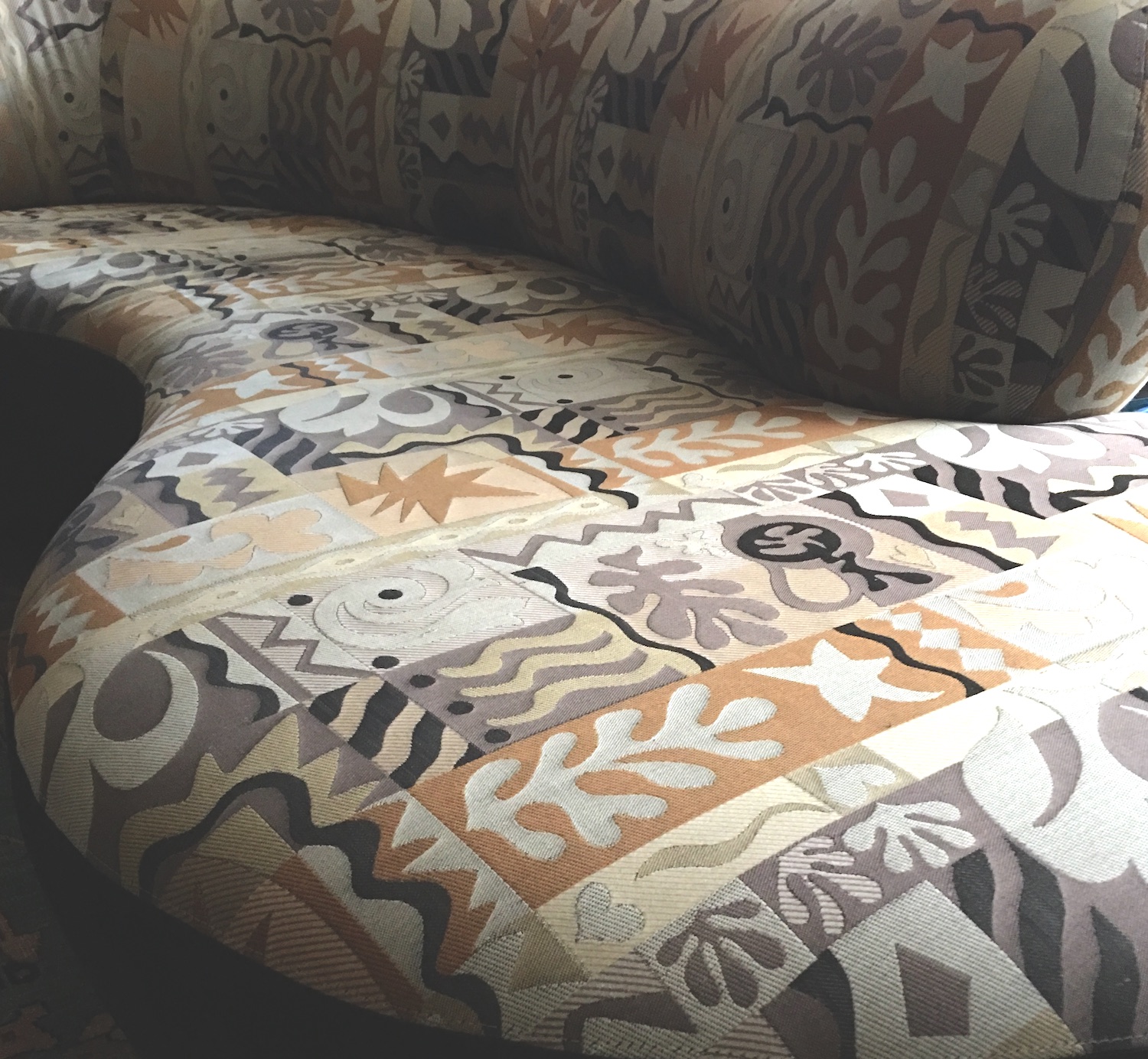

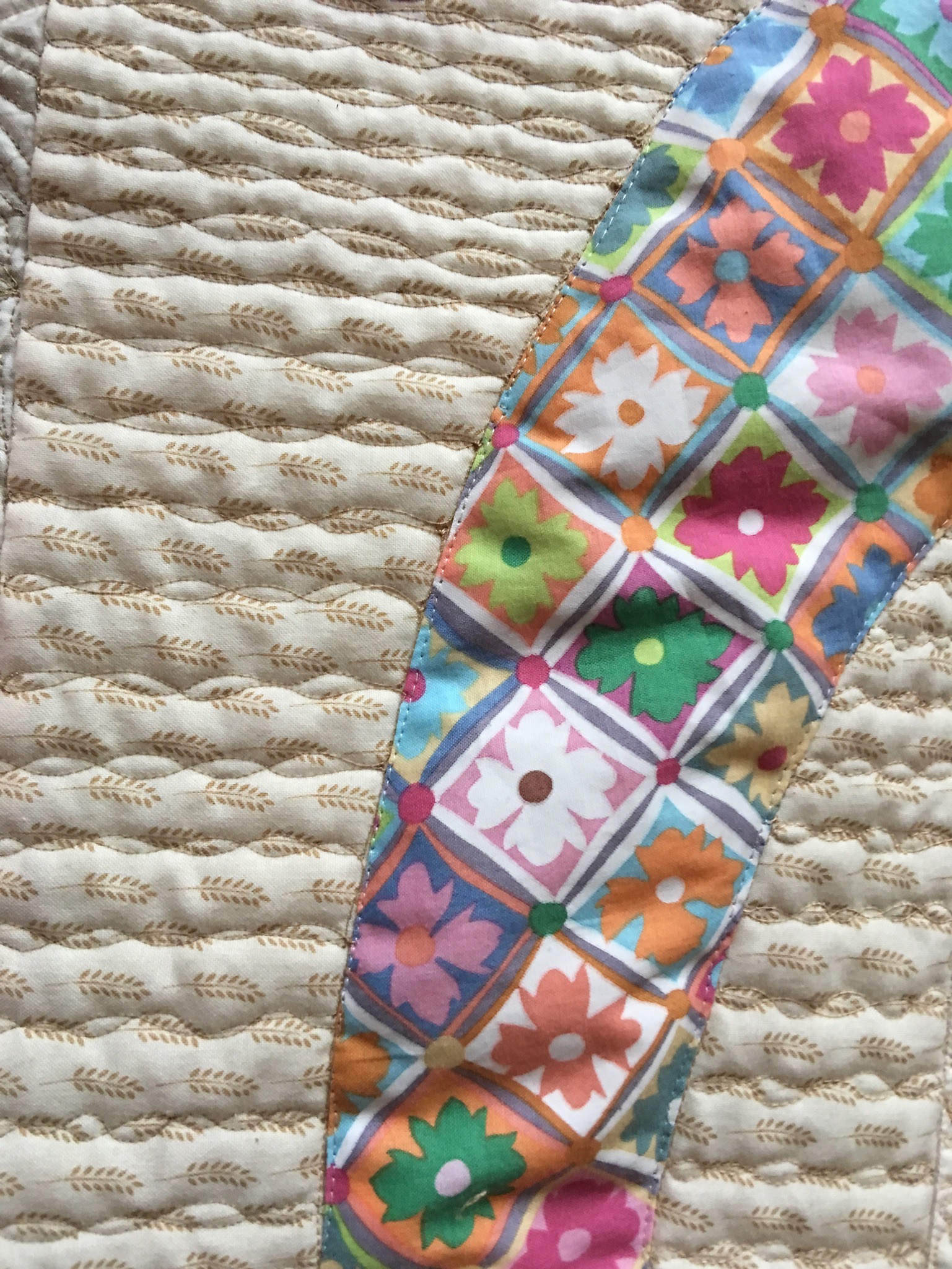 and this…
and this…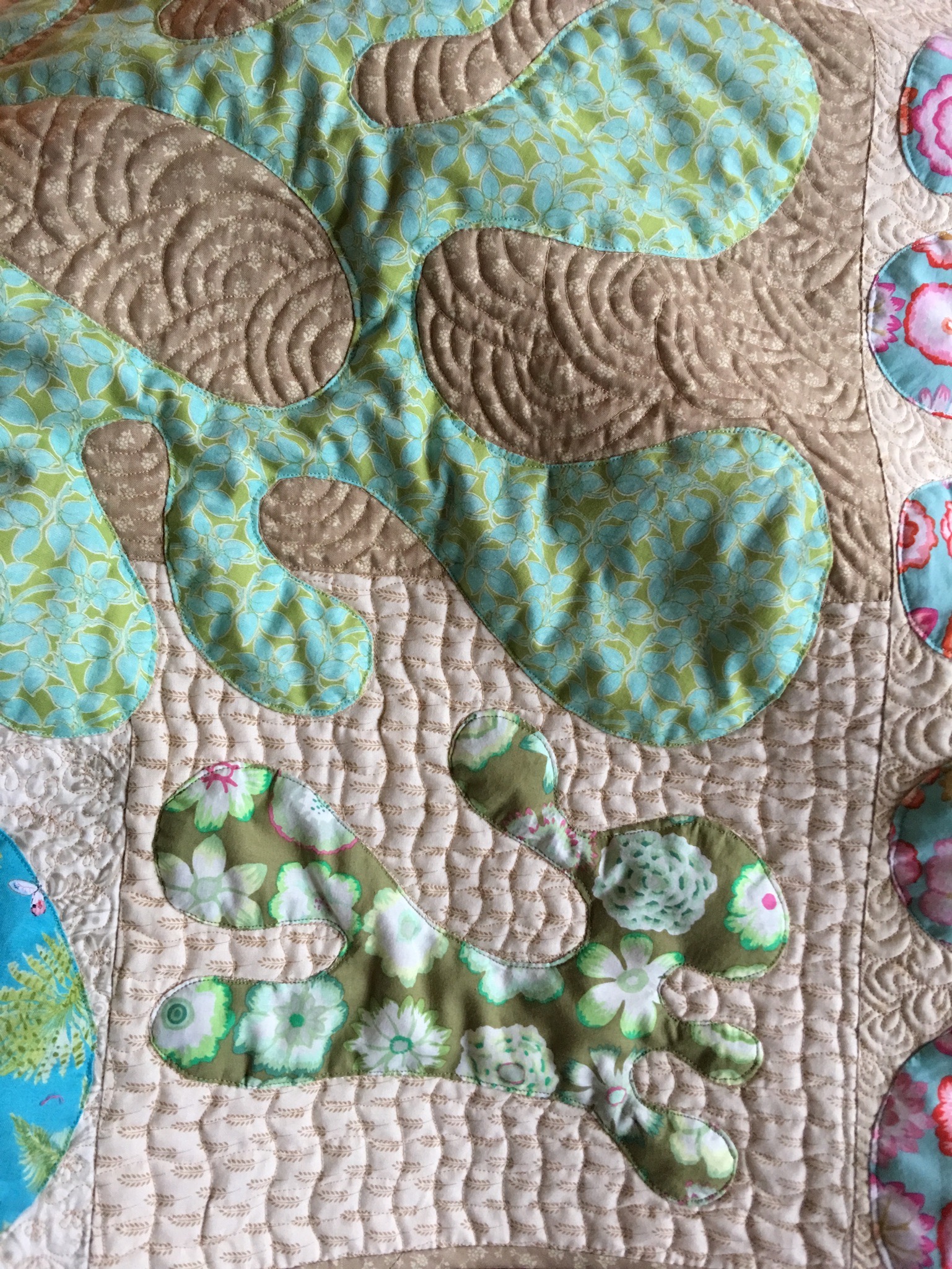 And this…
And this…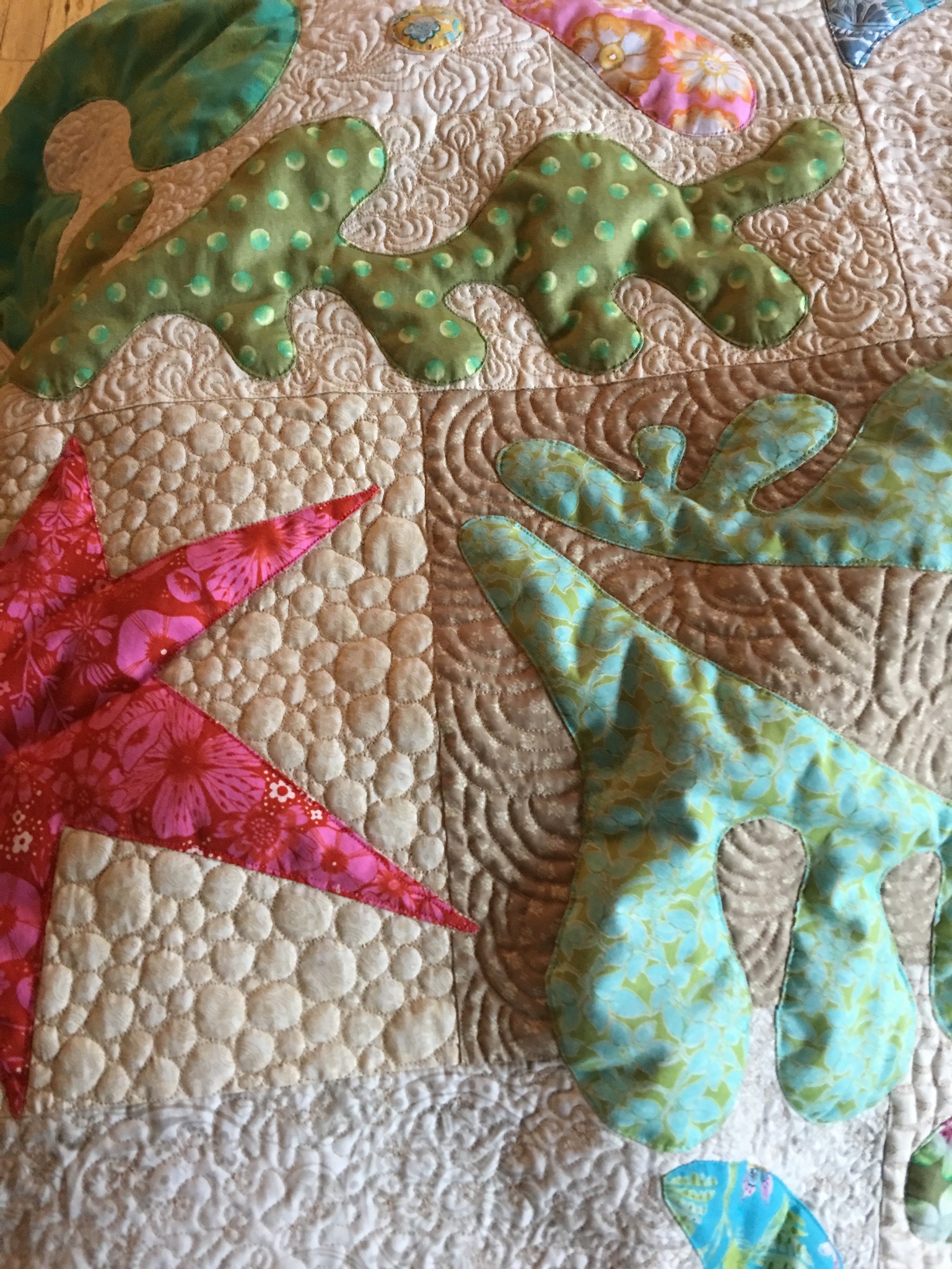
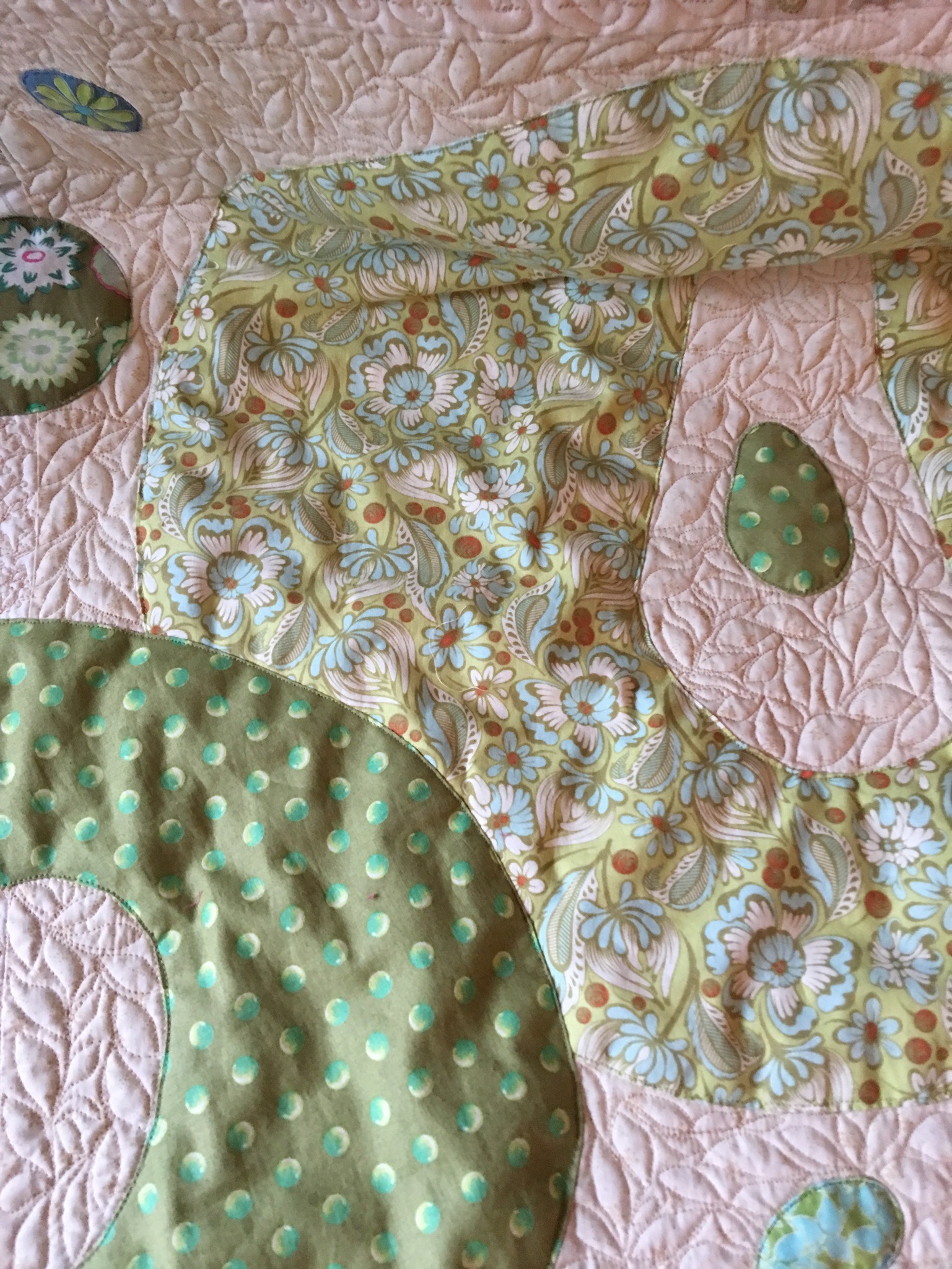 and this…
and this…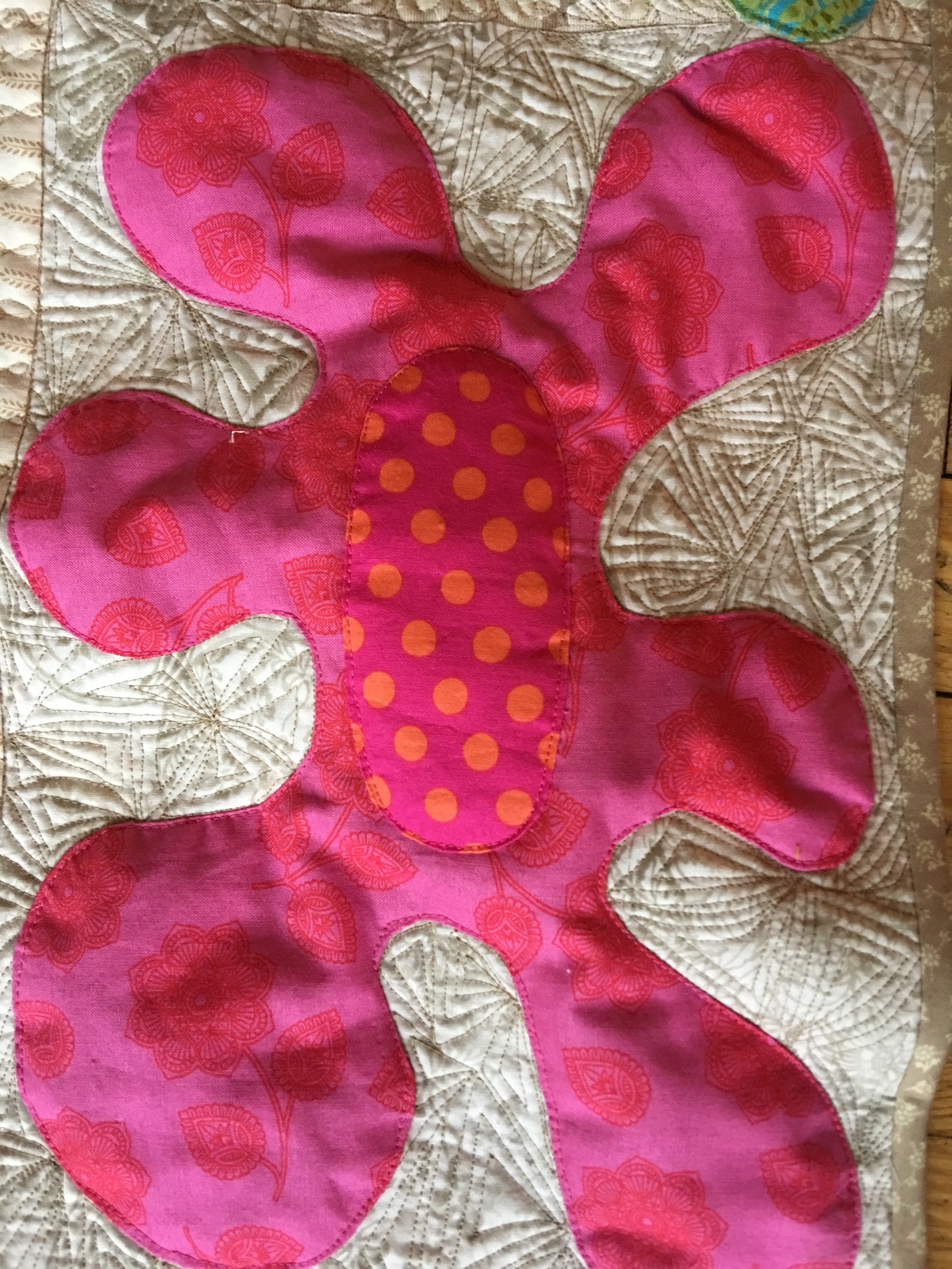 and this…
and this… With each block, I tried a different free motion quilting pattern that I thought complimented the shape in the block. I know many feel the shapes themselves should also be quilted and I may have to go back and quilt the larger shapes, but I wanted them to pop, so decided to leave them alone. Once all the blocks were quilted I agonized over the binding. Eventually I opted for the darkest background beige fabric I had used. I cut it on the bias, pieced it together and then following the instructions in Mimi Dietrich’s book, Happy Endings I bound the whole quilt with mitered corners. I added a label and voila!
With each block, I tried a different free motion quilting pattern that I thought complimented the shape in the block. I know many feel the shapes themselves should also be quilted and I may have to go back and quilt the larger shapes, but I wanted them to pop, so decided to leave them alone. Once all the blocks were quilted I agonized over the binding. Eventually I opted for the darkest background beige fabric I had used. I cut it on the bias, pieced it together and then following the instructions in Mimi Dietrich’s book, Happy Endings I bound the whole quilt with mitered corners. I added a label and voila!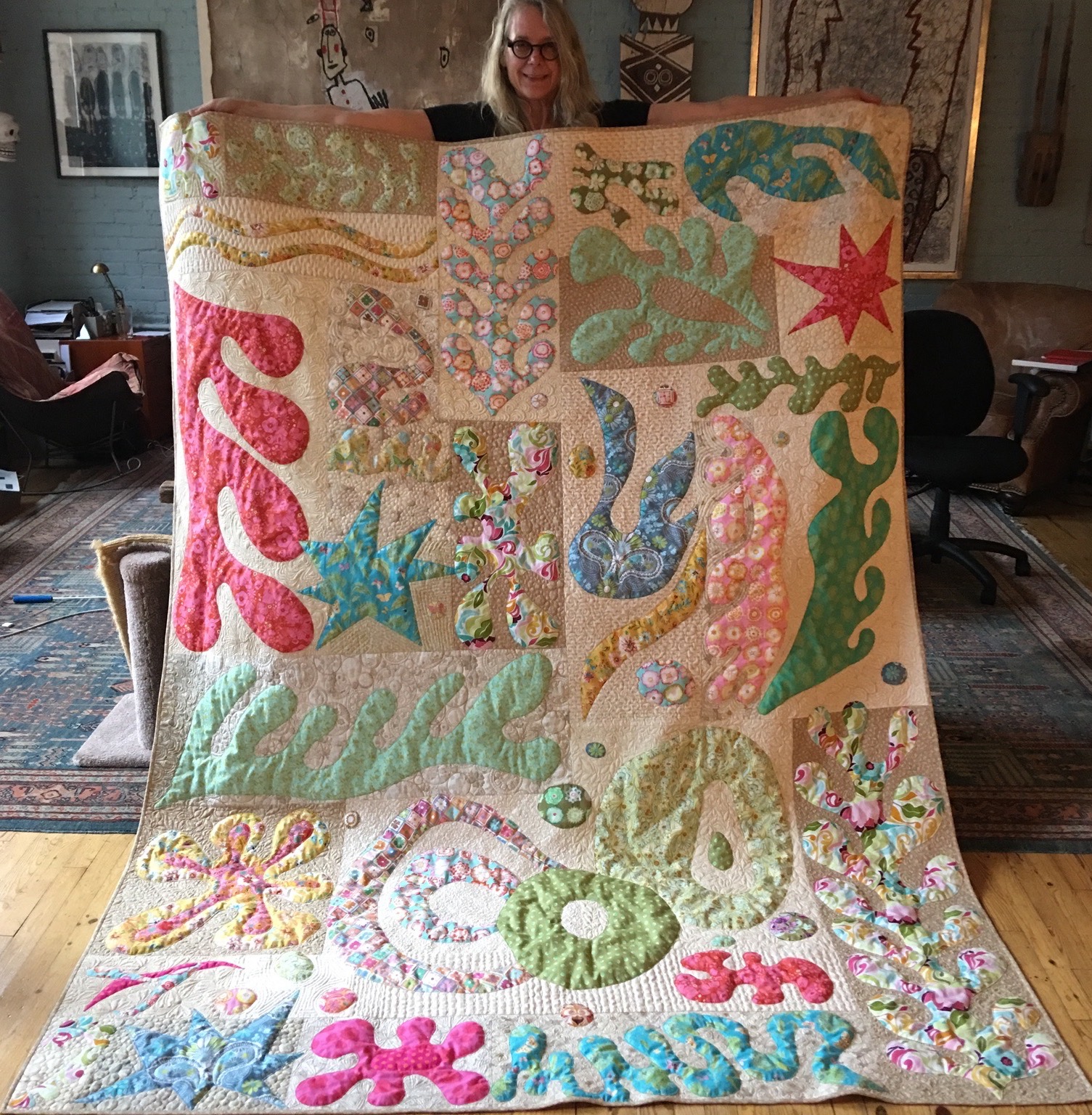
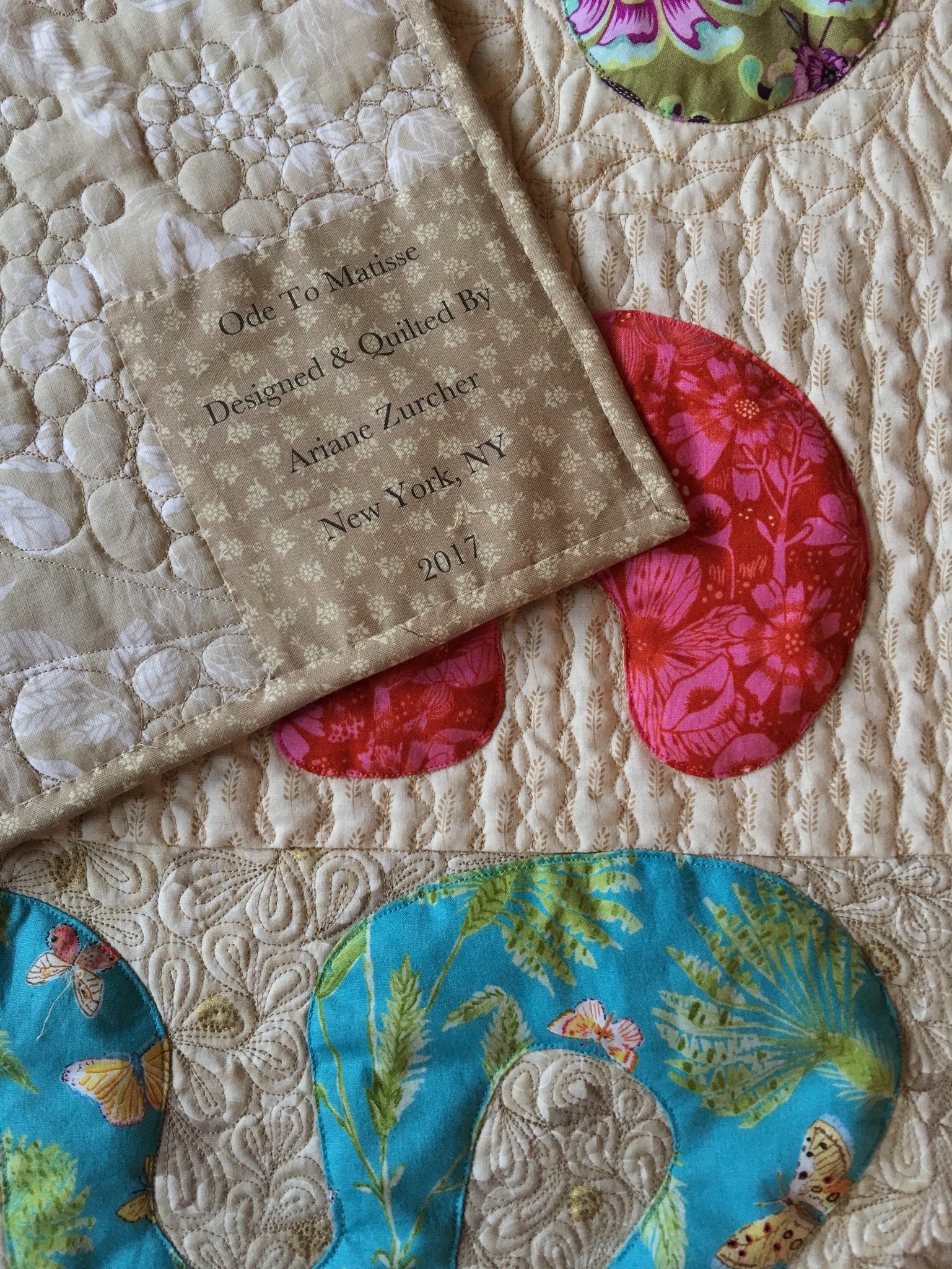
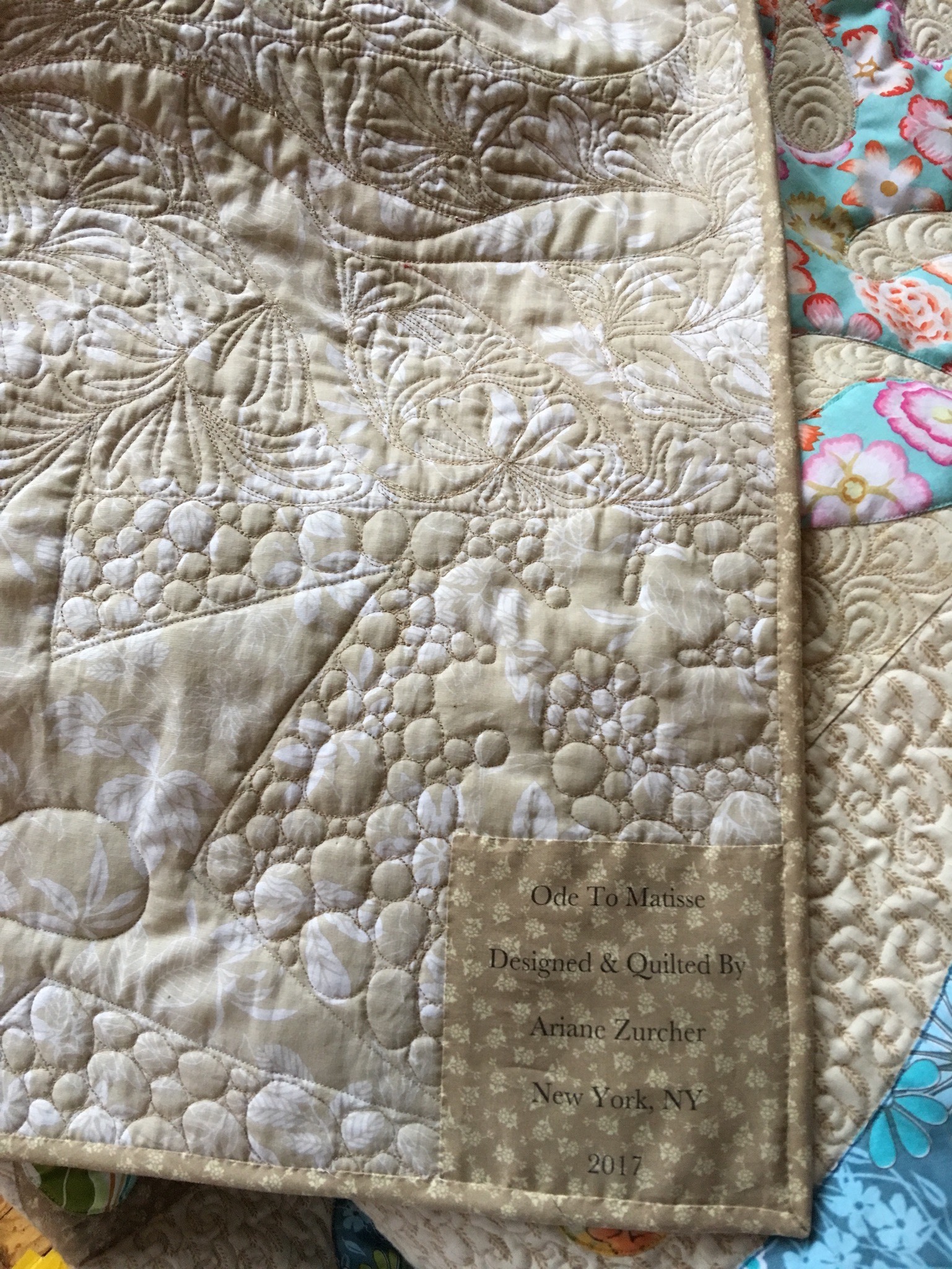
 Then, having given up on the idea that I was going to be miraculously hit with a blast of inspiration, I cut up the fabric (just a little, nothing radical) and sewed it back together (photo below.) And then I sent it off to my class for feedback, that’s the whole reaching out thing that I mentioned above… Elizabeth is an excellent teacher and can be depended upon to make terrific suggestions.
Then, having given up on the idea that I was going to be miraculously hit with a blast of inspiration, I cut up the fabric (just a little, nothing radical) and sewed it back together (photo below.) And then I sent it off to my class for feedback, that’s the whole reaching out thing that I mentioned above… Elizabeth is an excellent teacher and can be depended upon to make terrific suggestions. 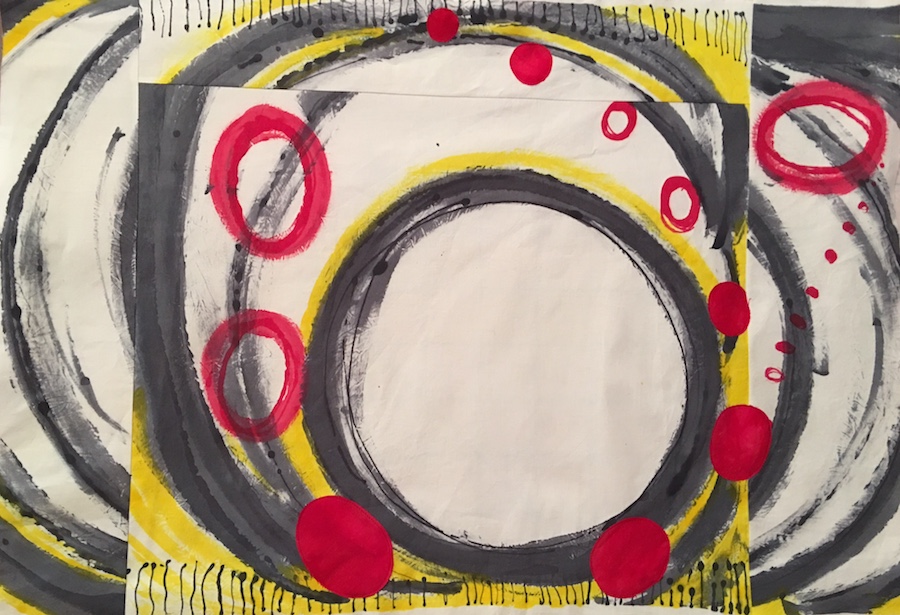 Which led to this…
Which led to this…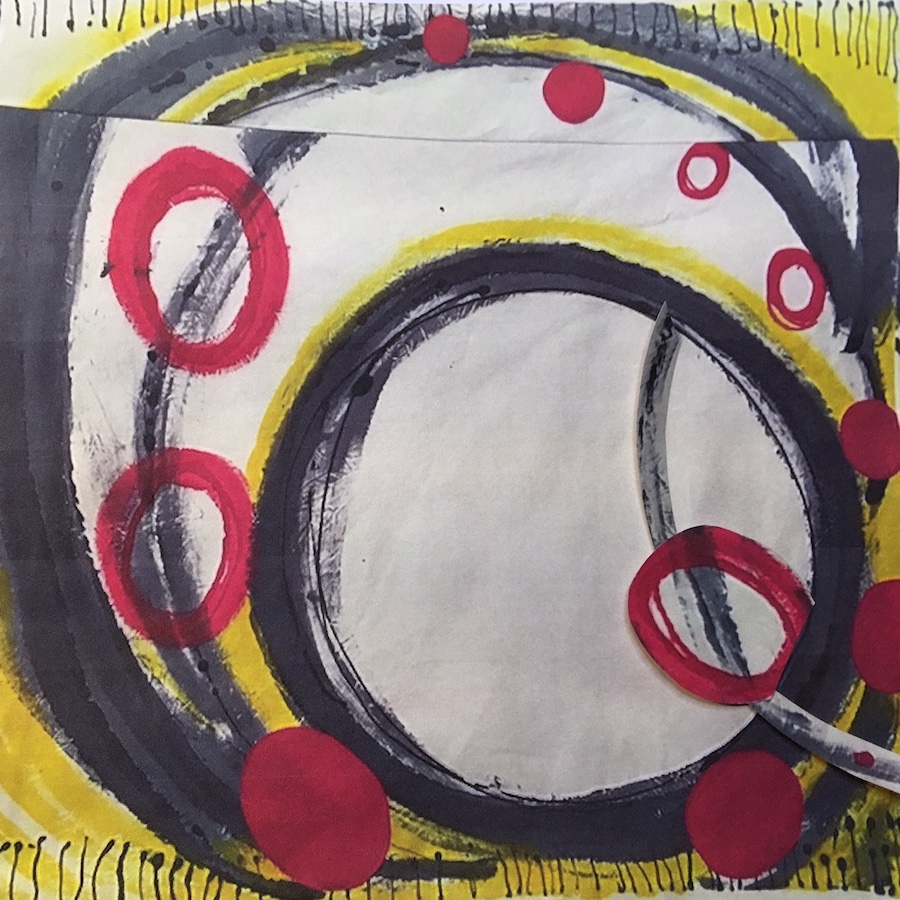 And this…
And this…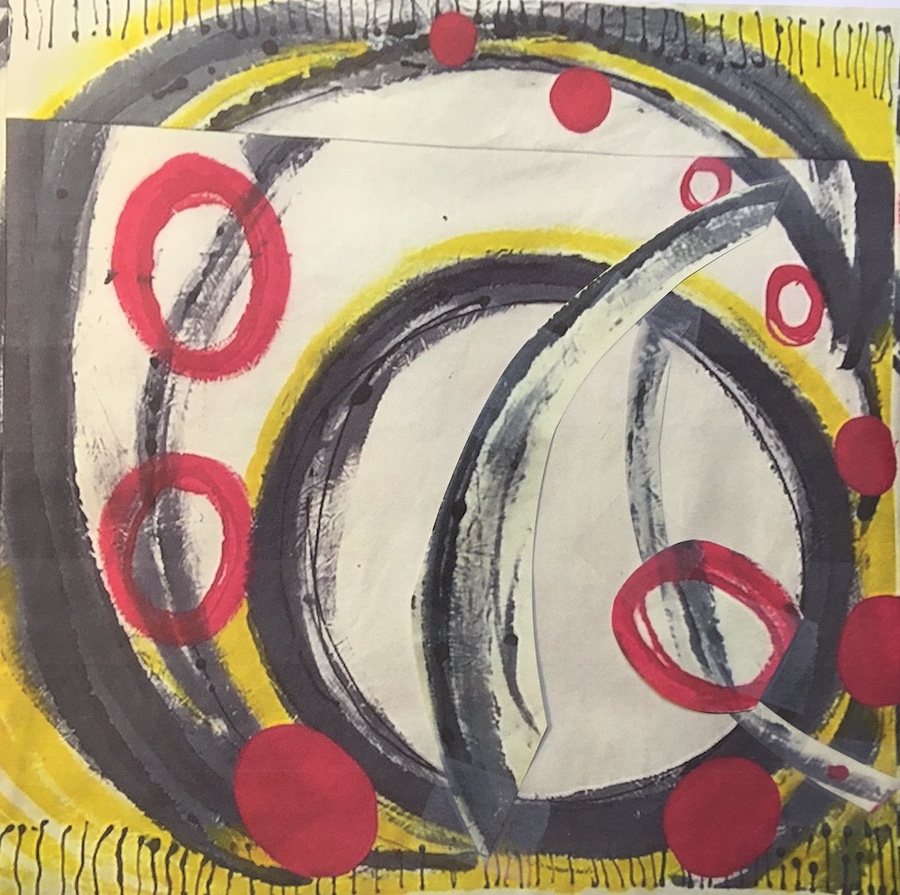 And this…
And this…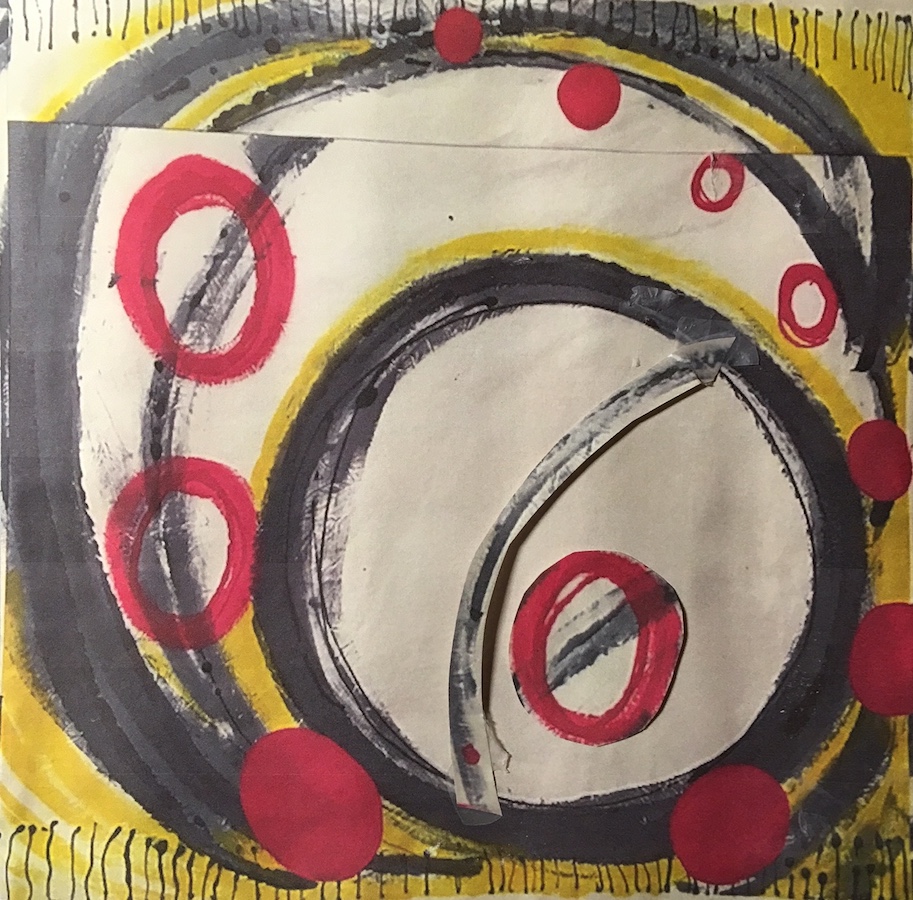
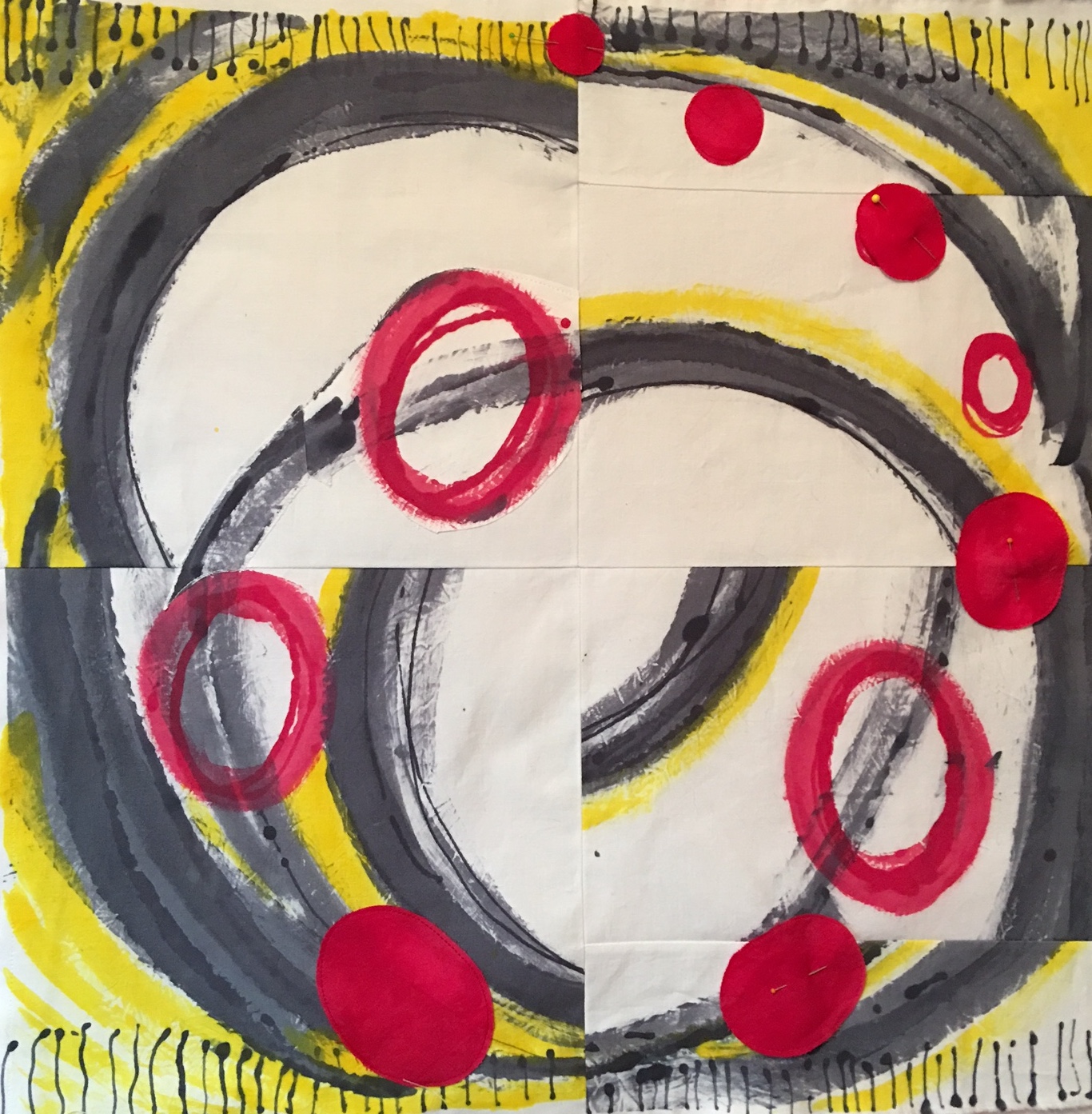 Which became this… traveling along our various paths…
Which became this… traveling along our various paths… And finally, this… reaching out to others and no longer feeling so alone…
And finally, this… reaching out to others and no longer feeling so alone…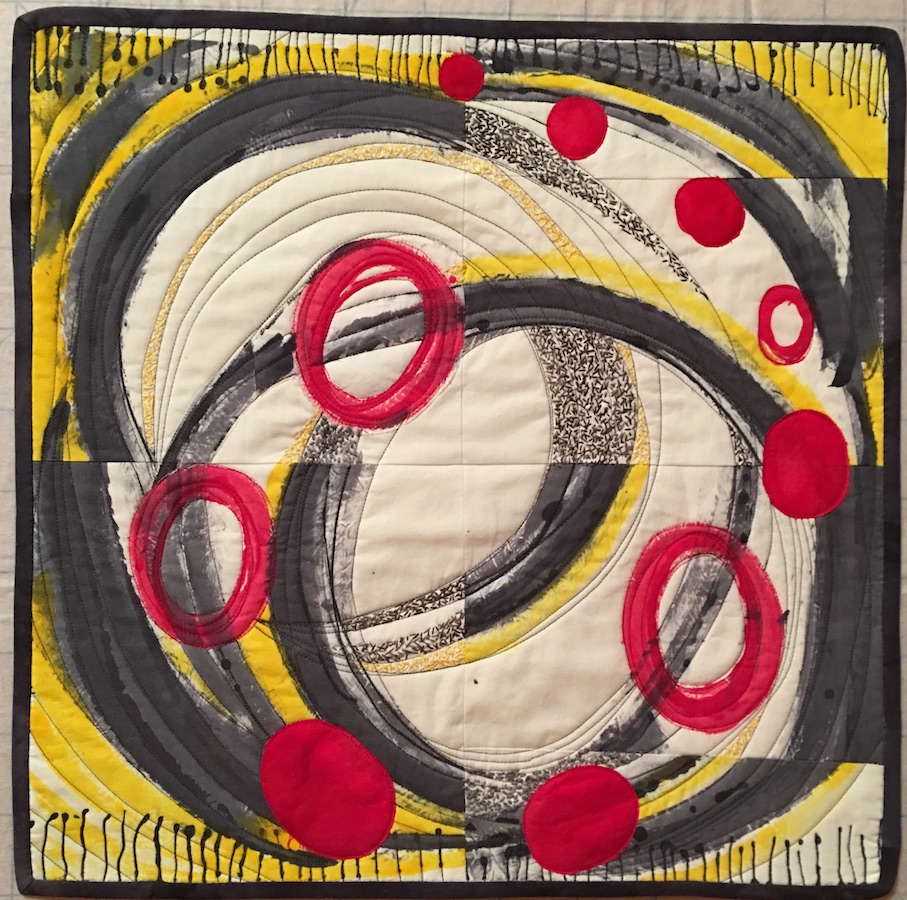 Here are a few close ups of the machine and hand stitching…
Here are a few close ups of the machine and hand stitching…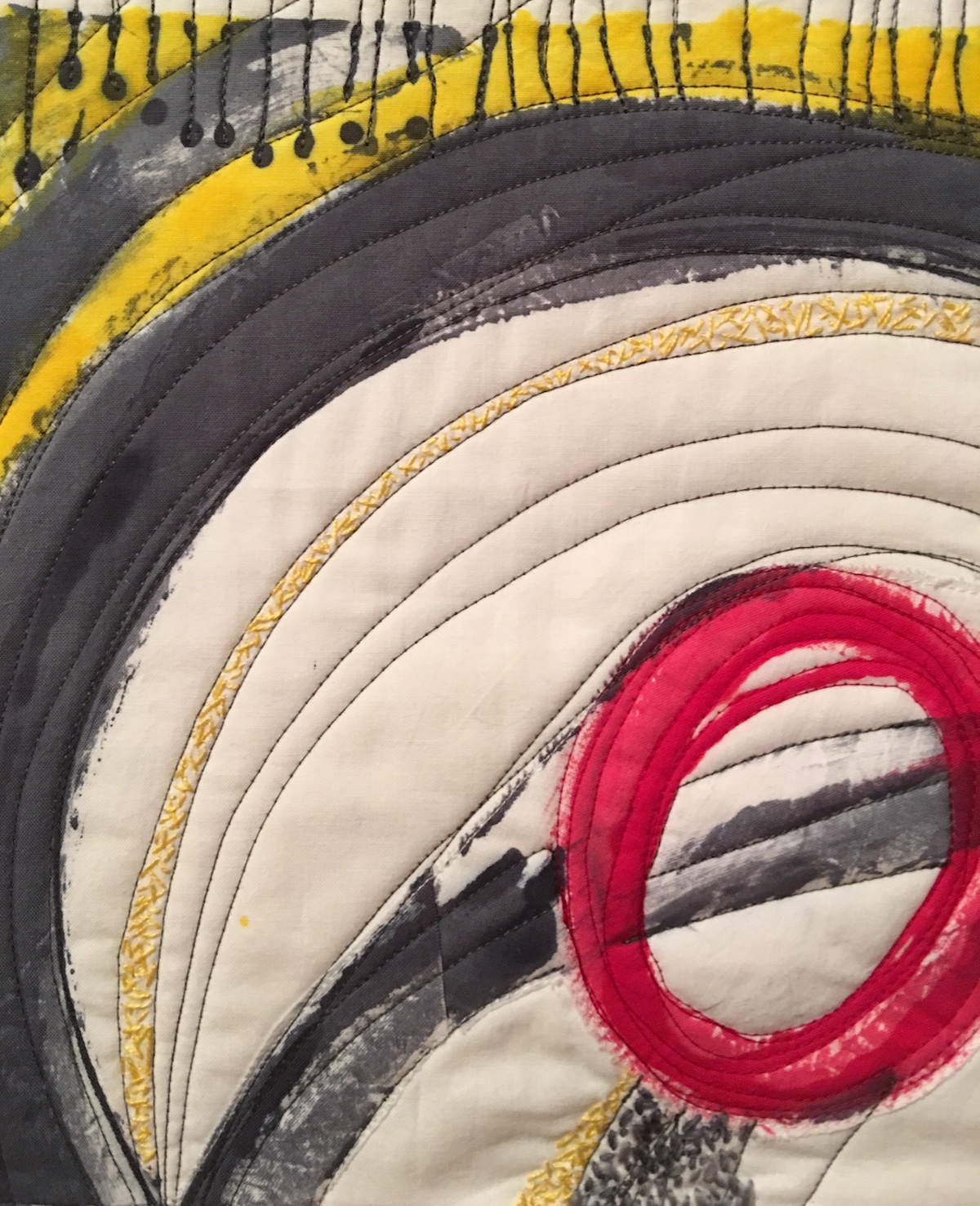
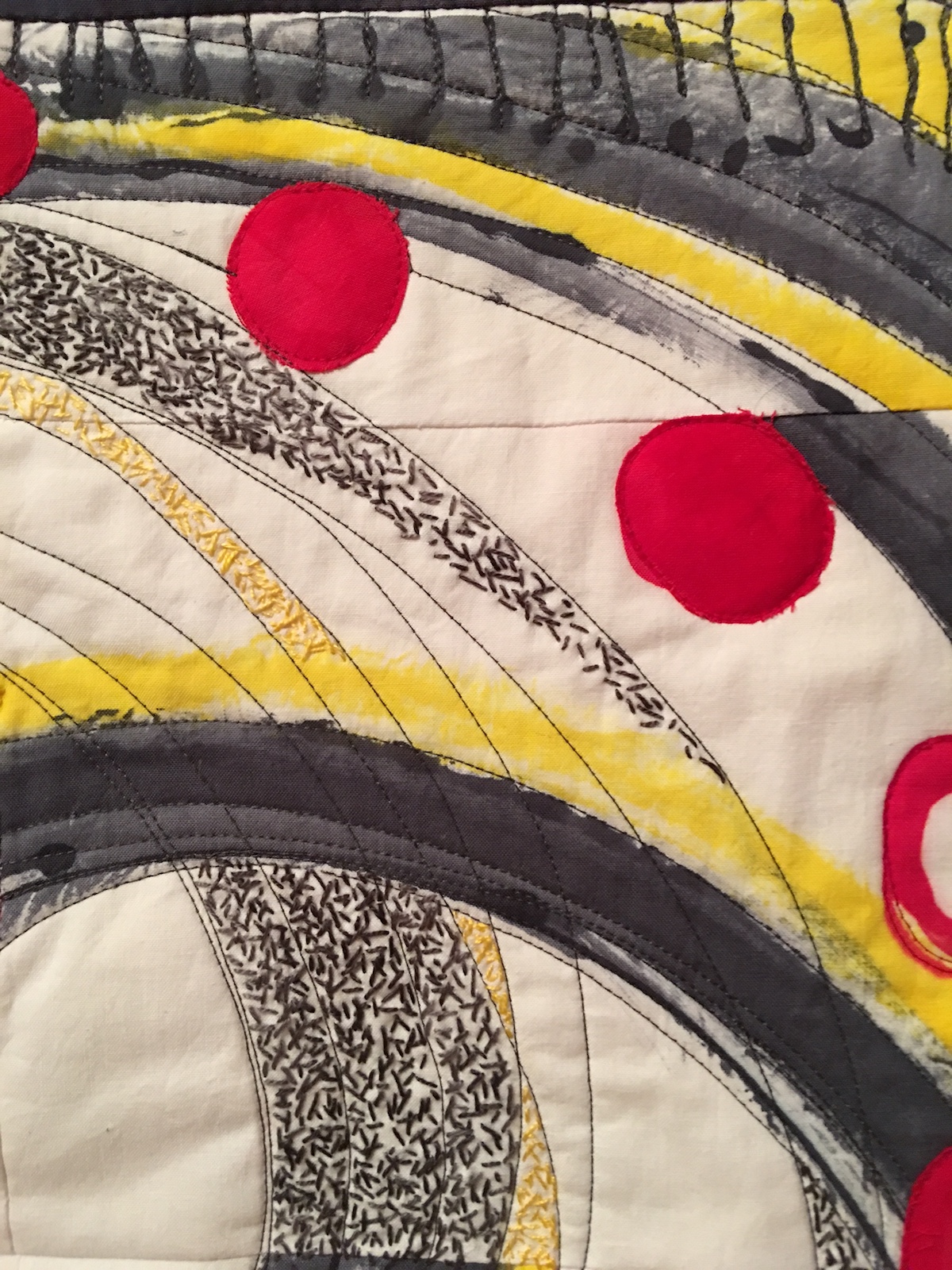
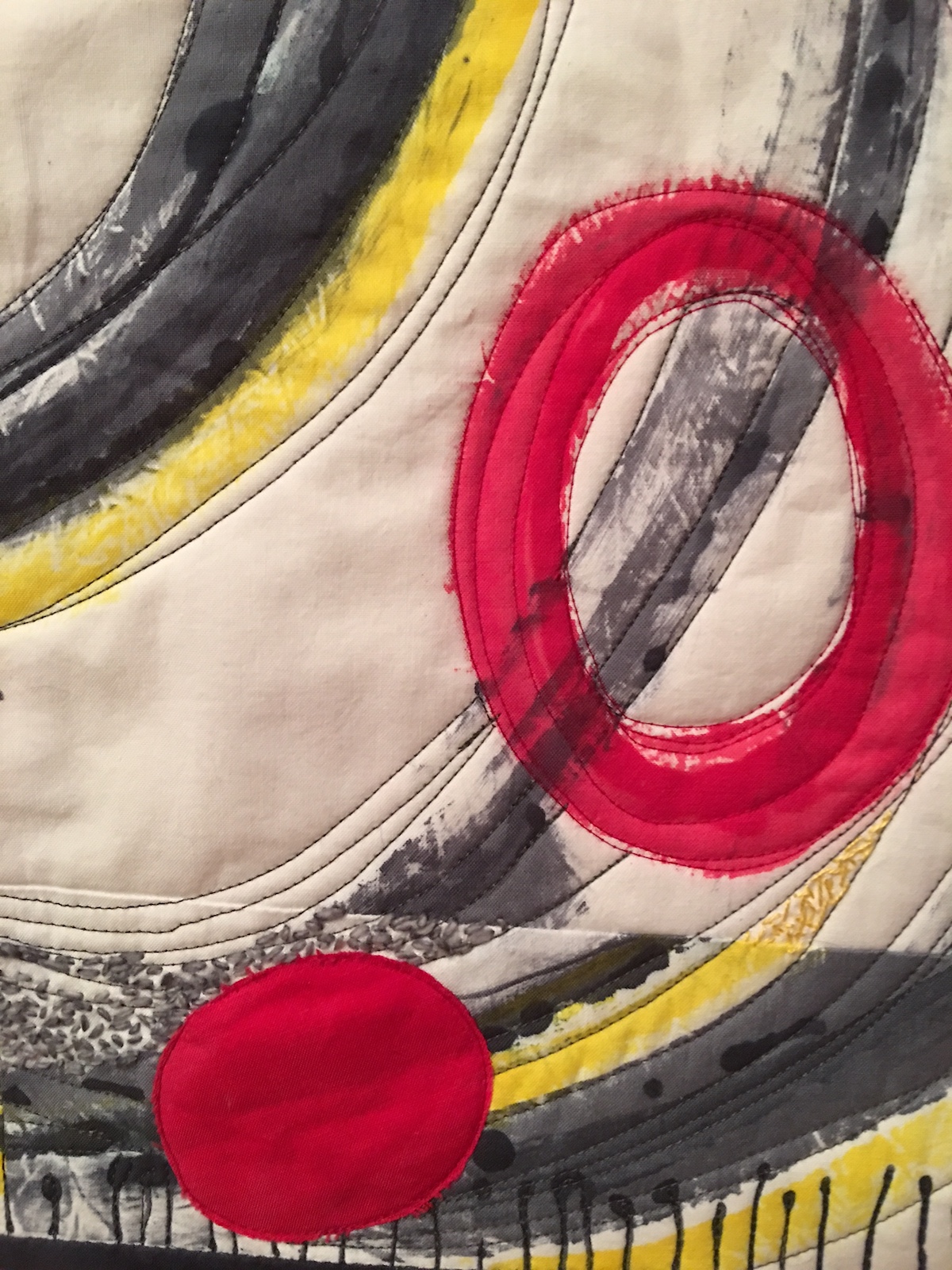
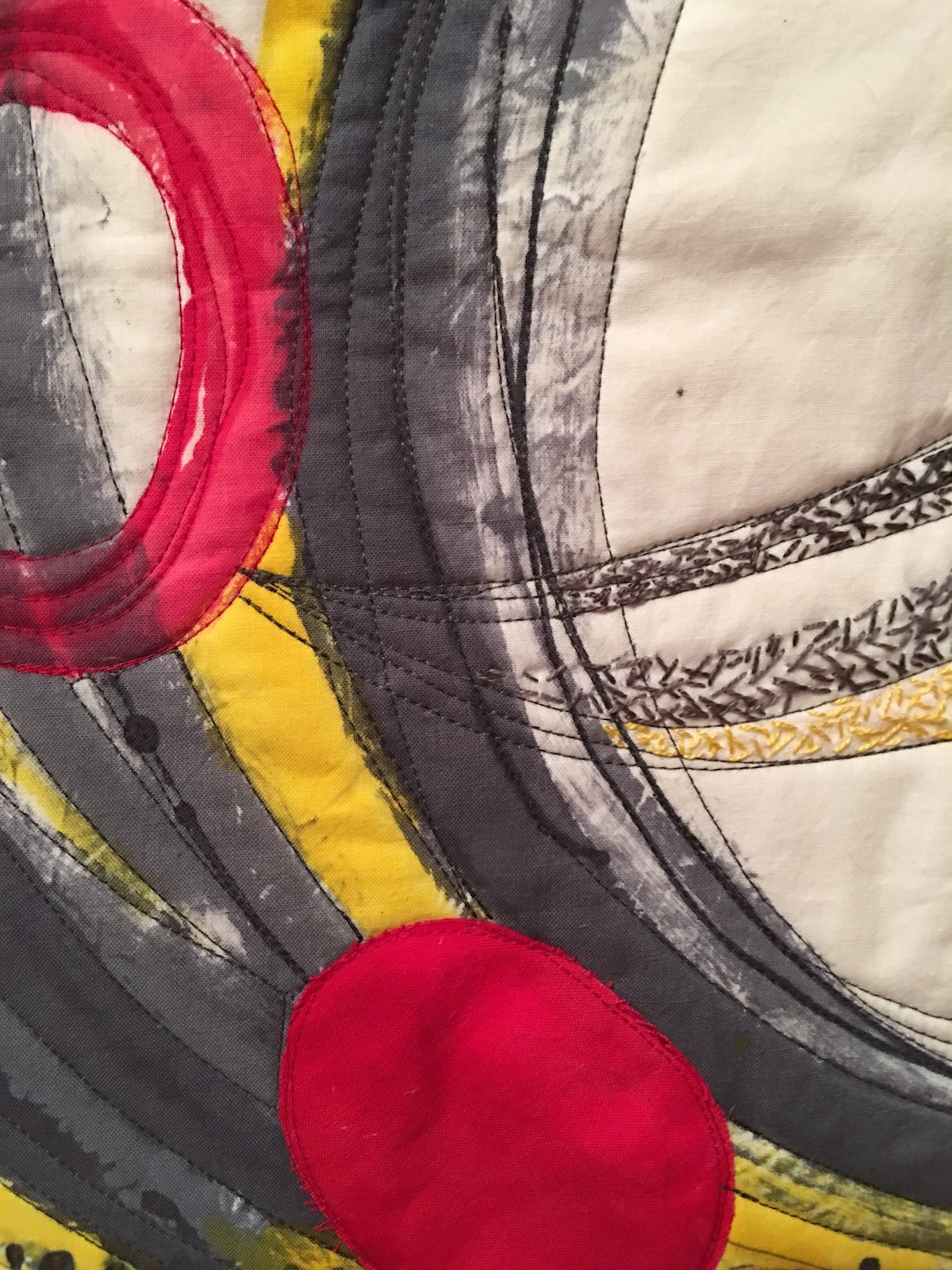
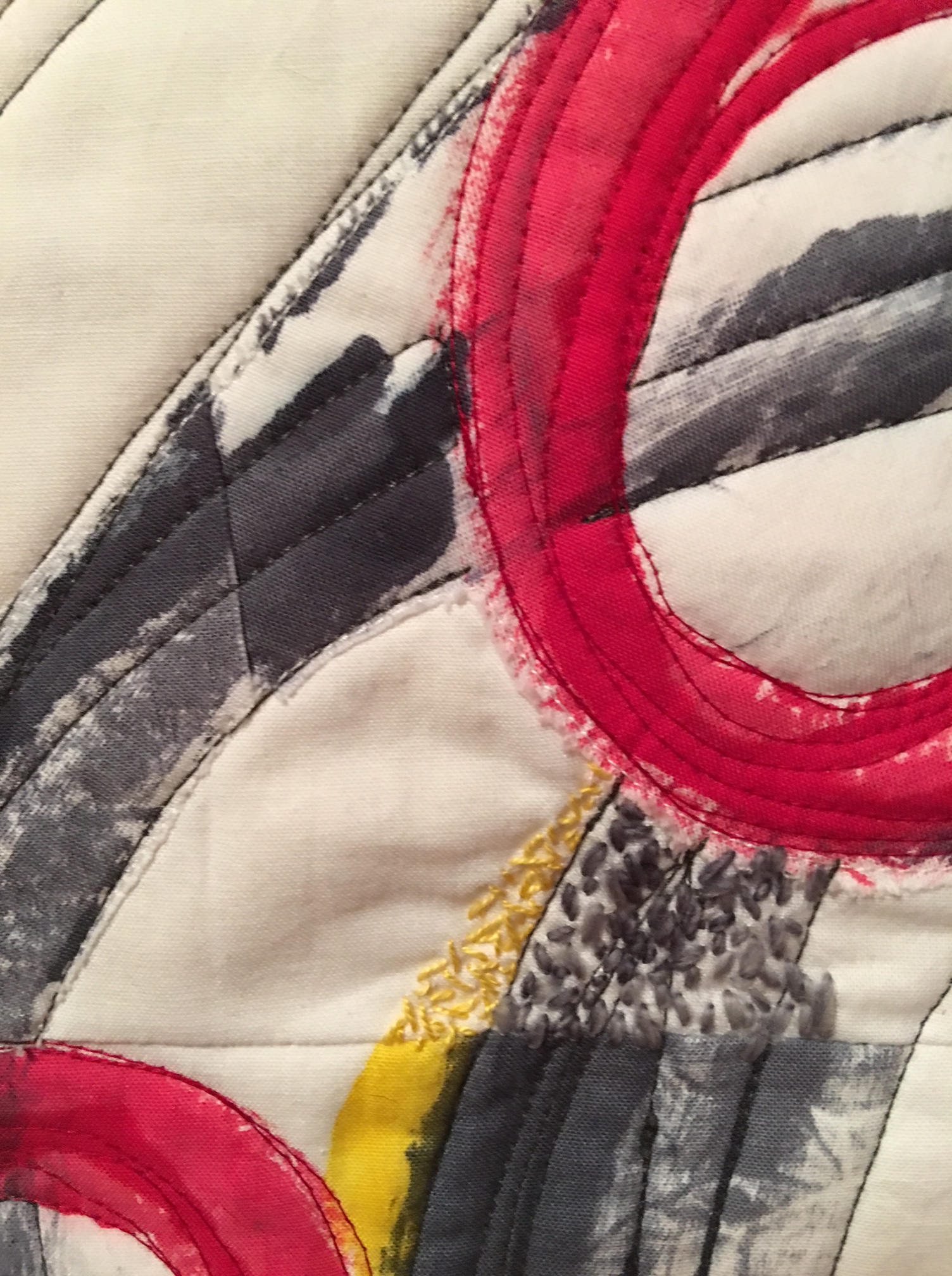
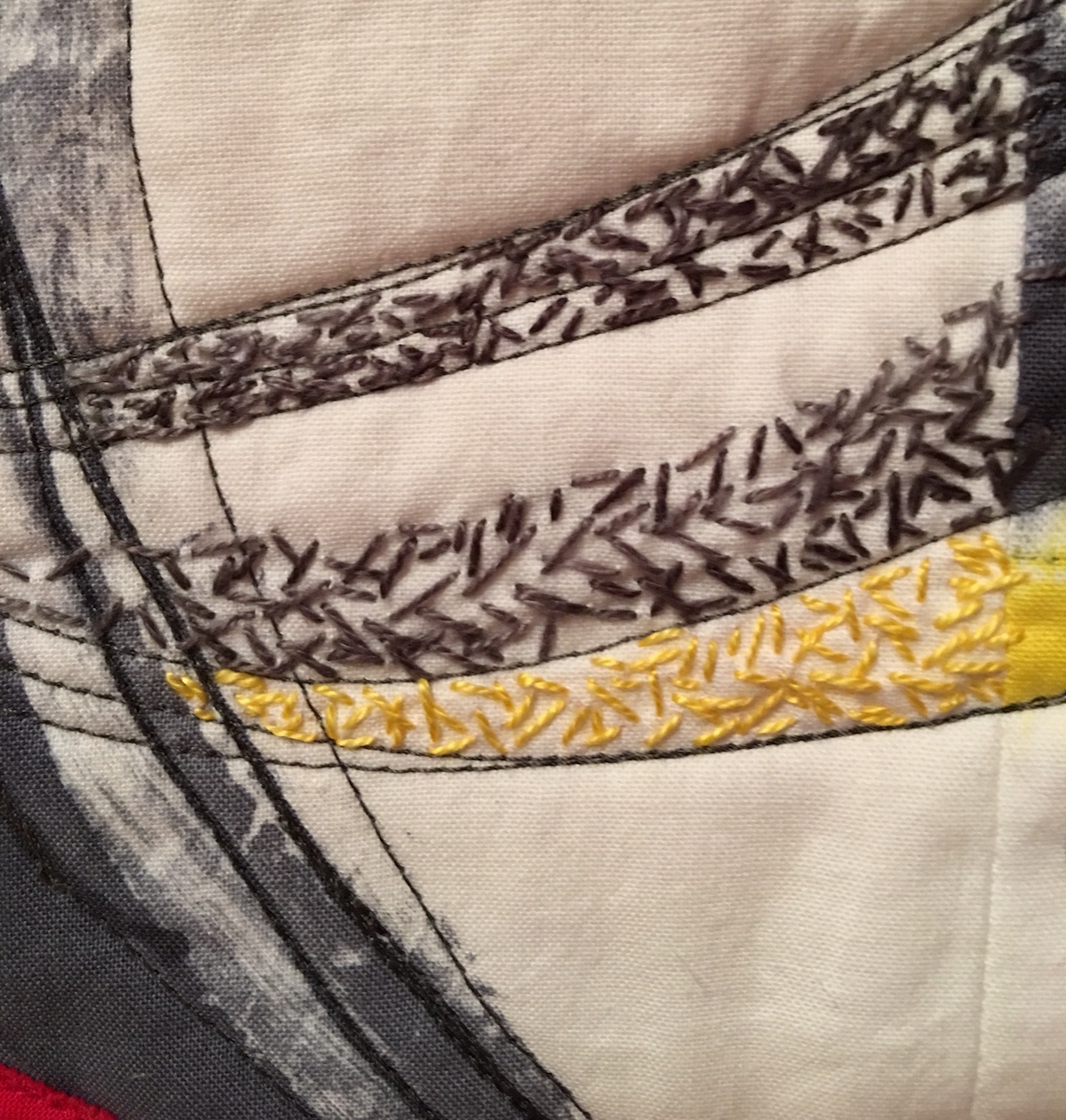
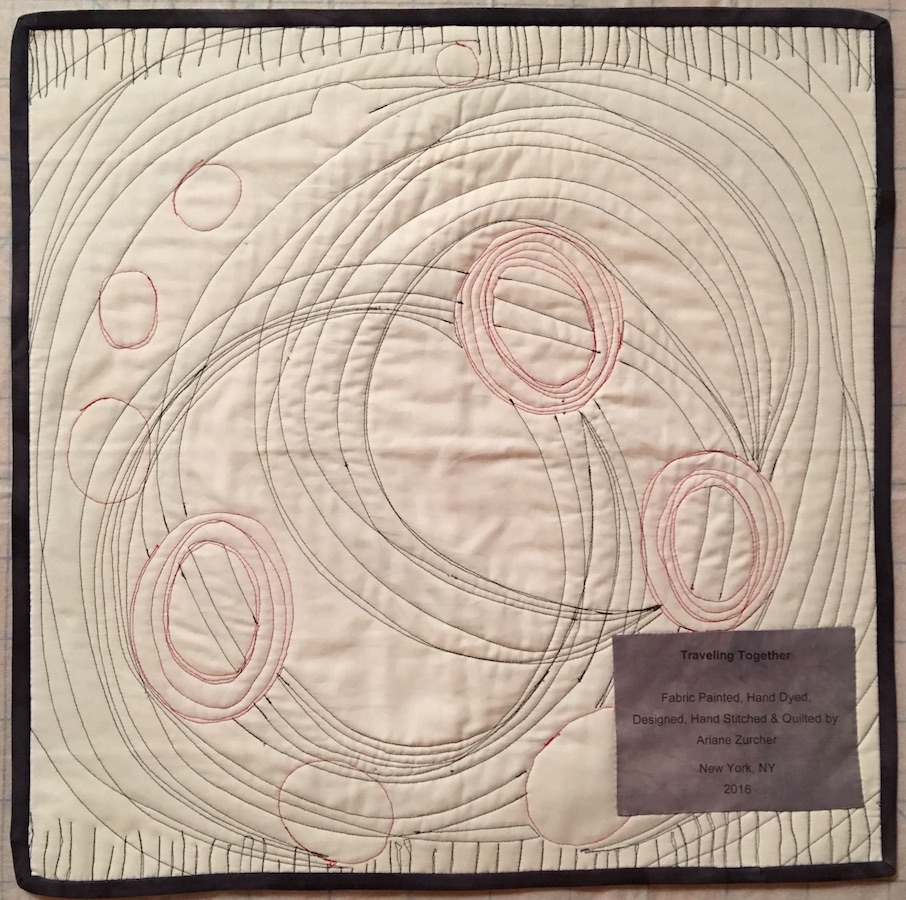
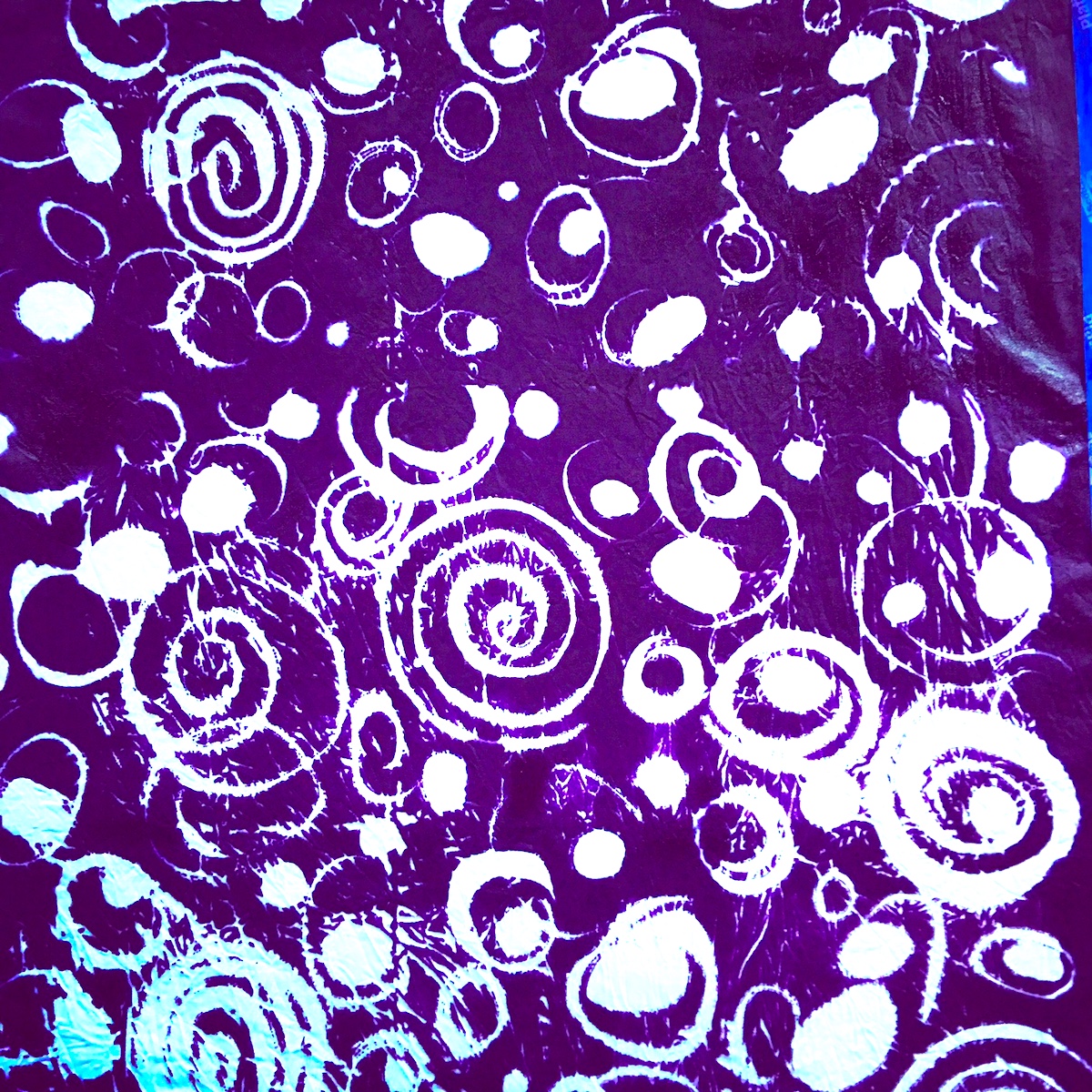
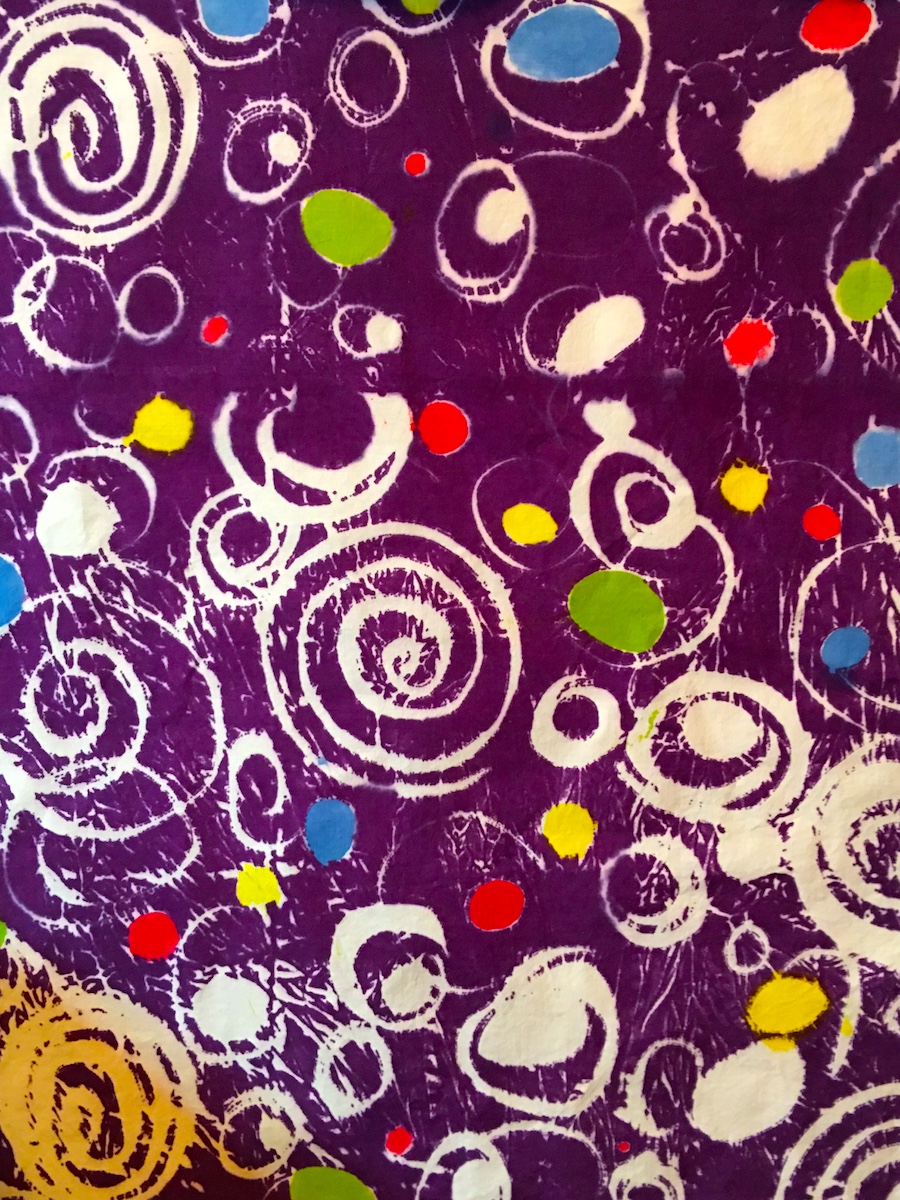
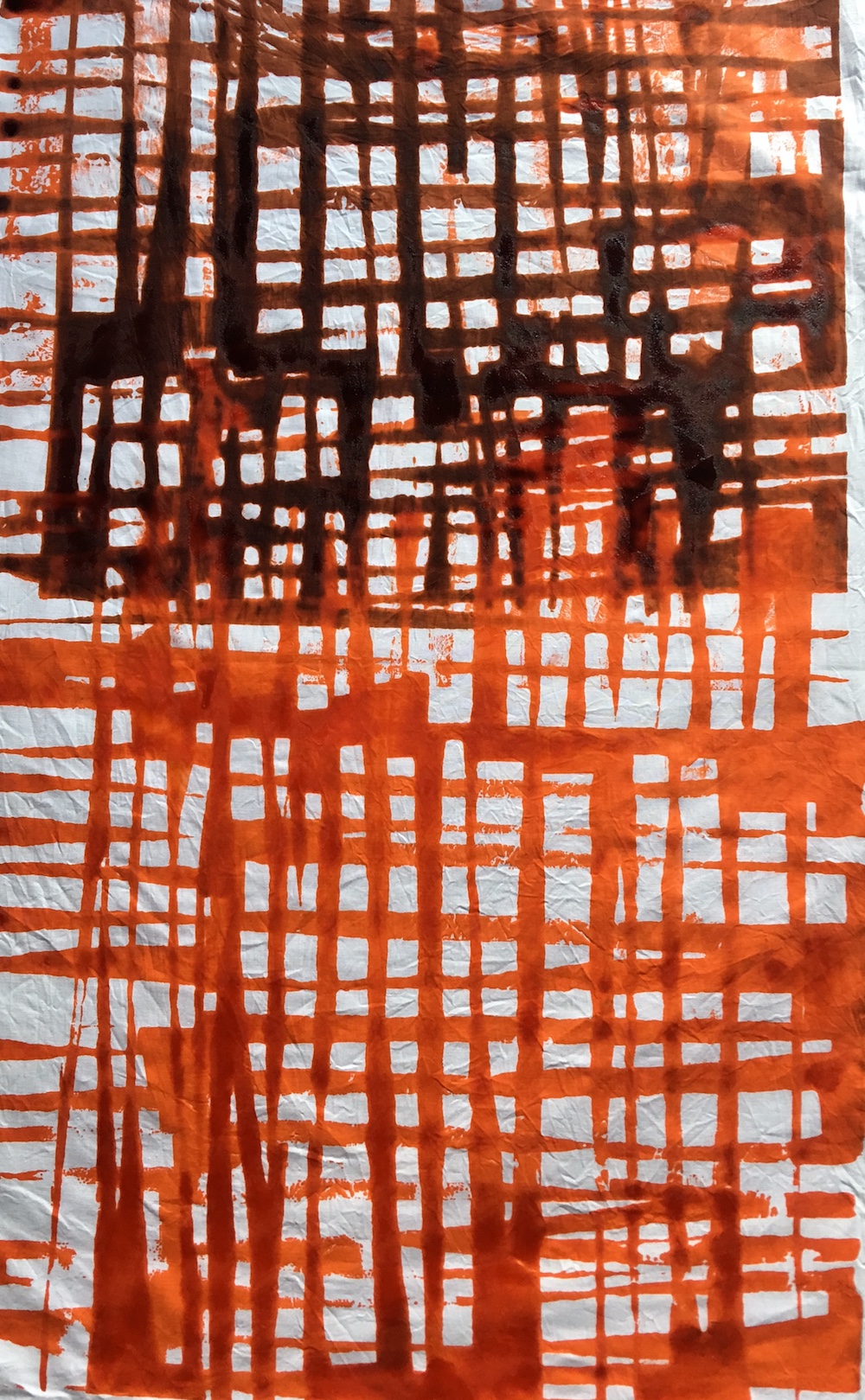

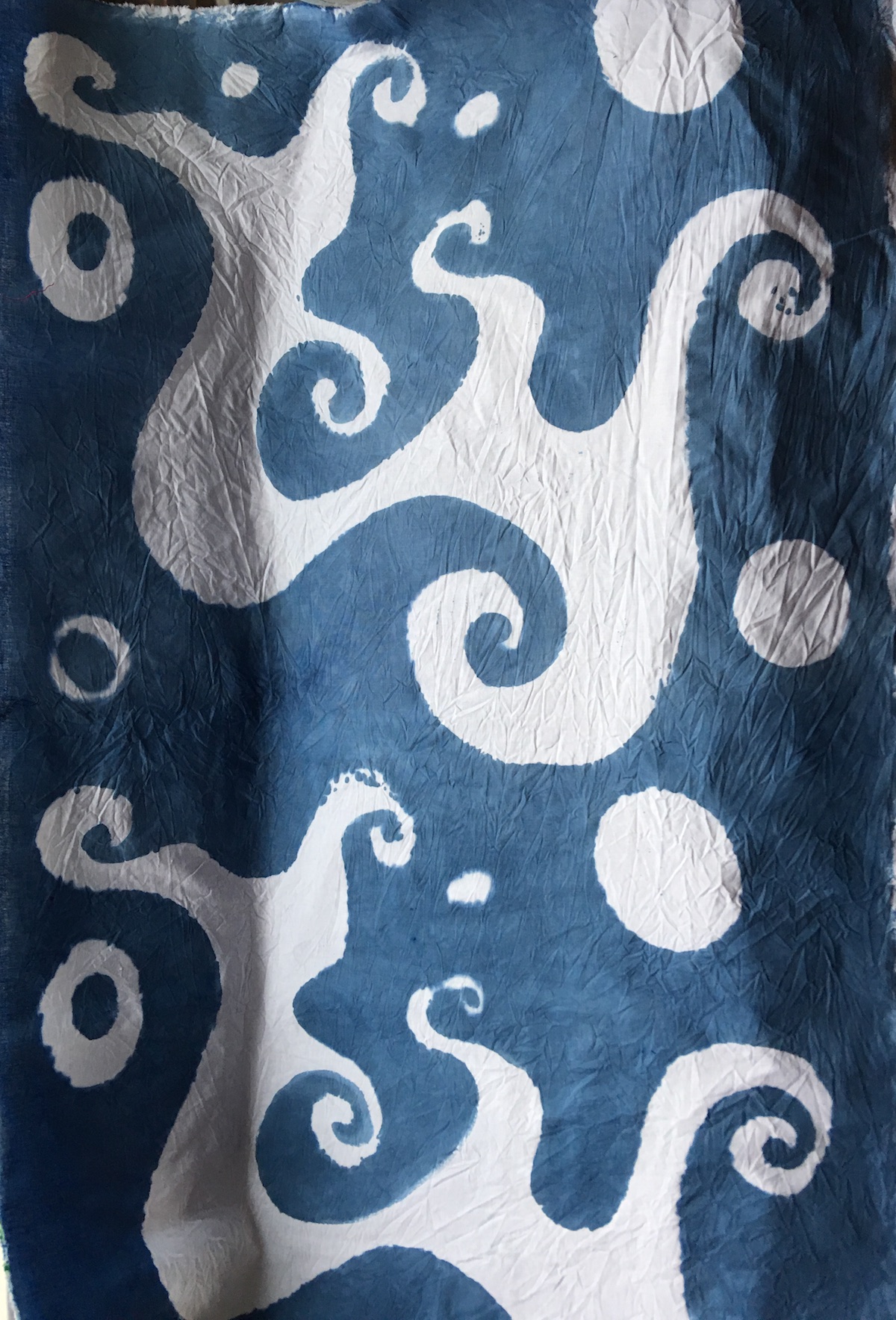
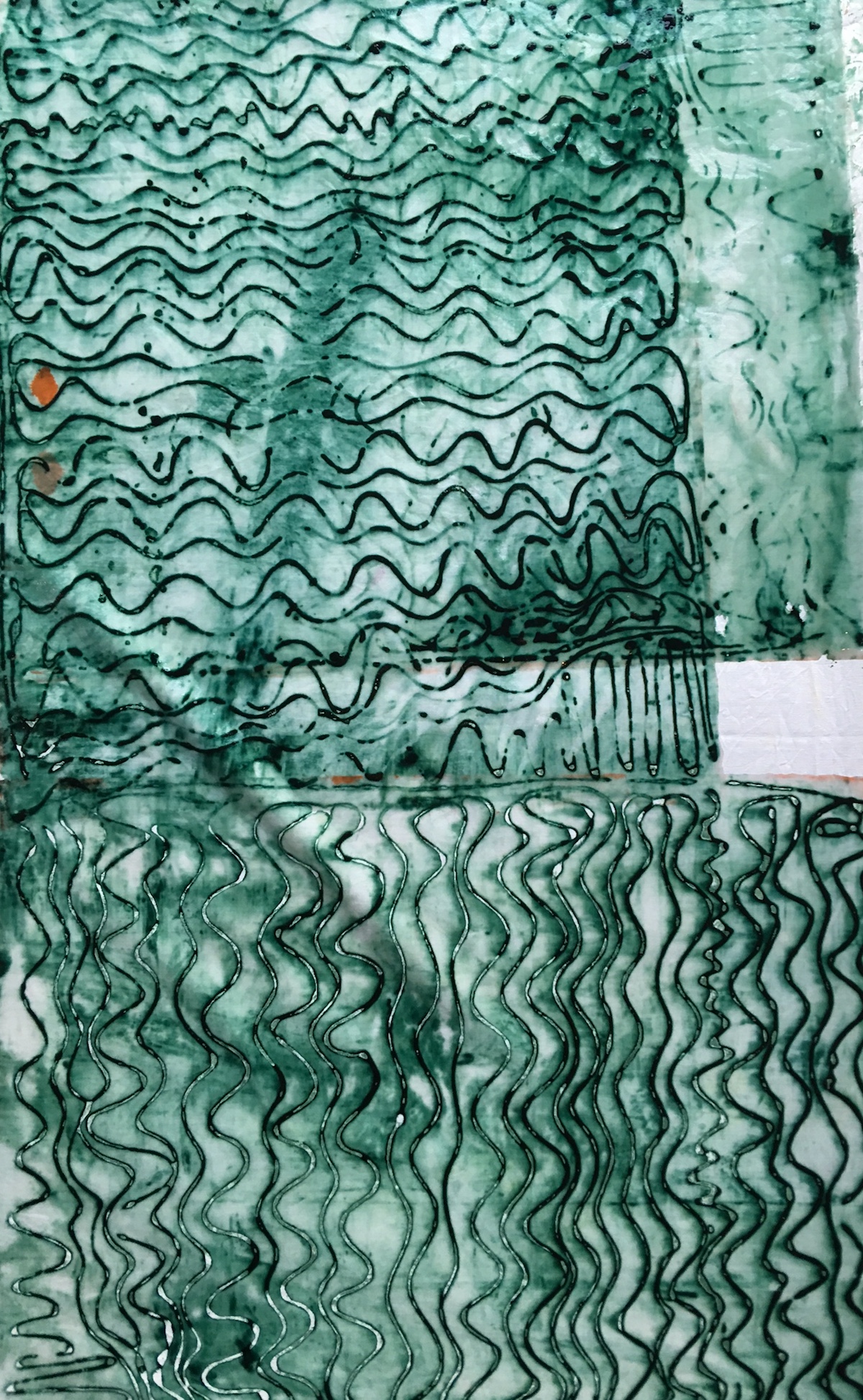
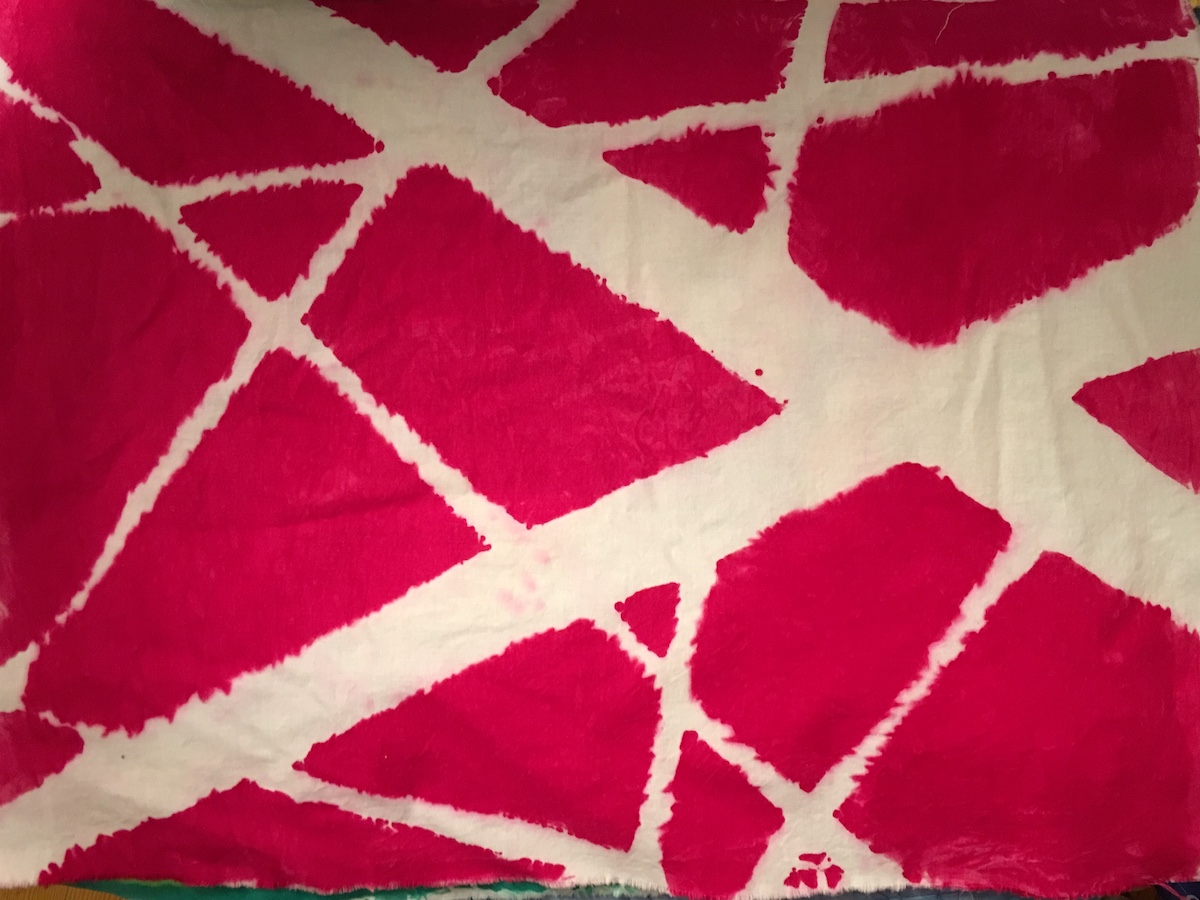
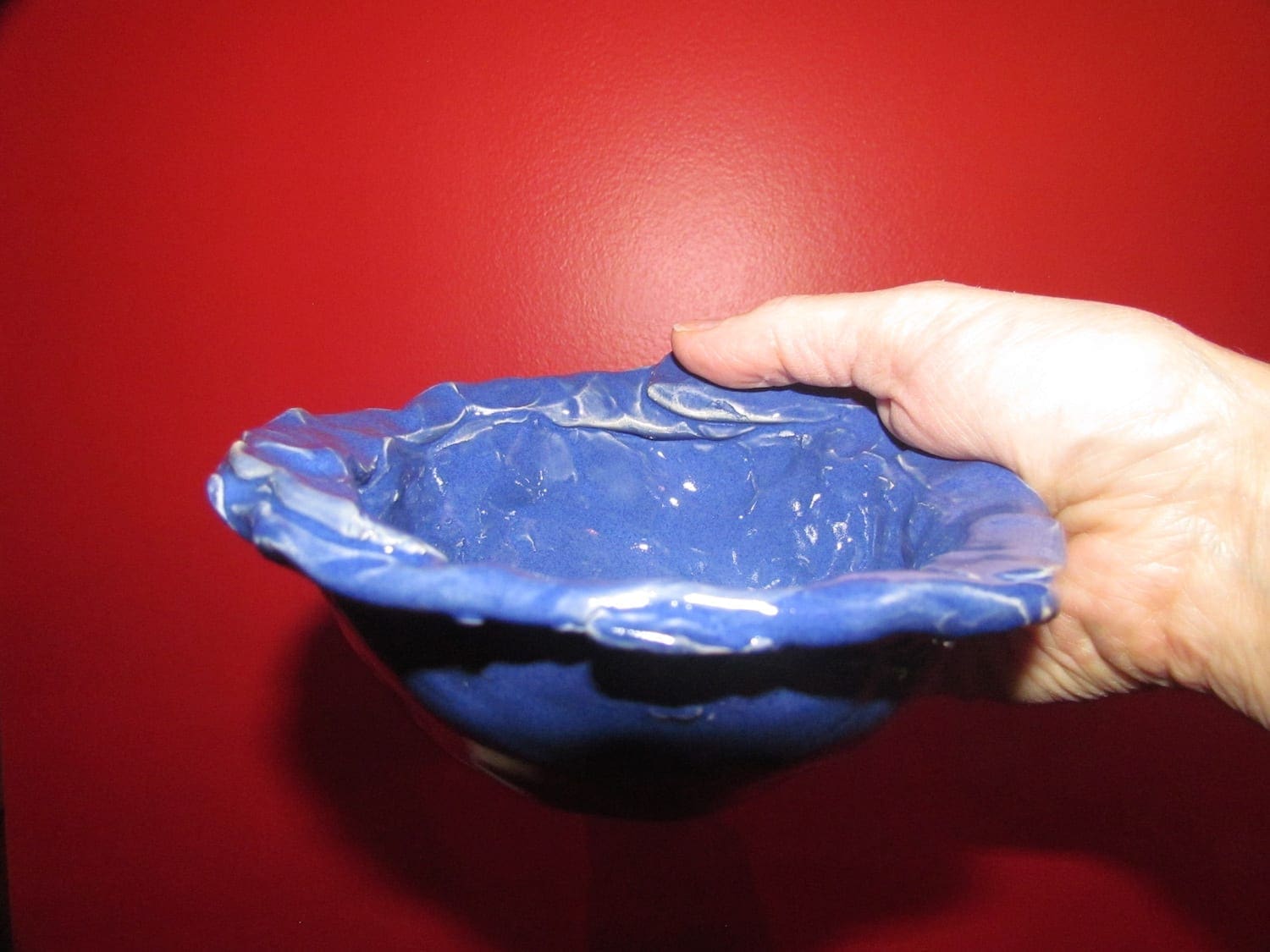

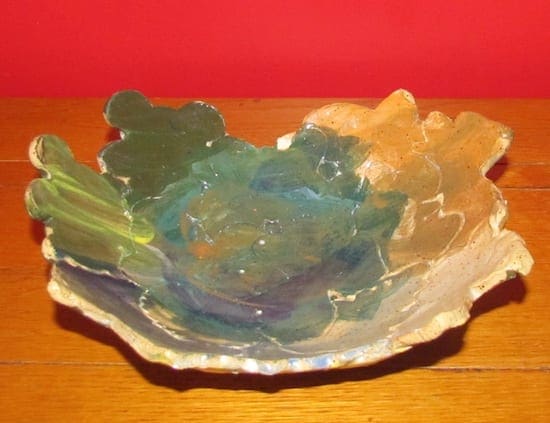
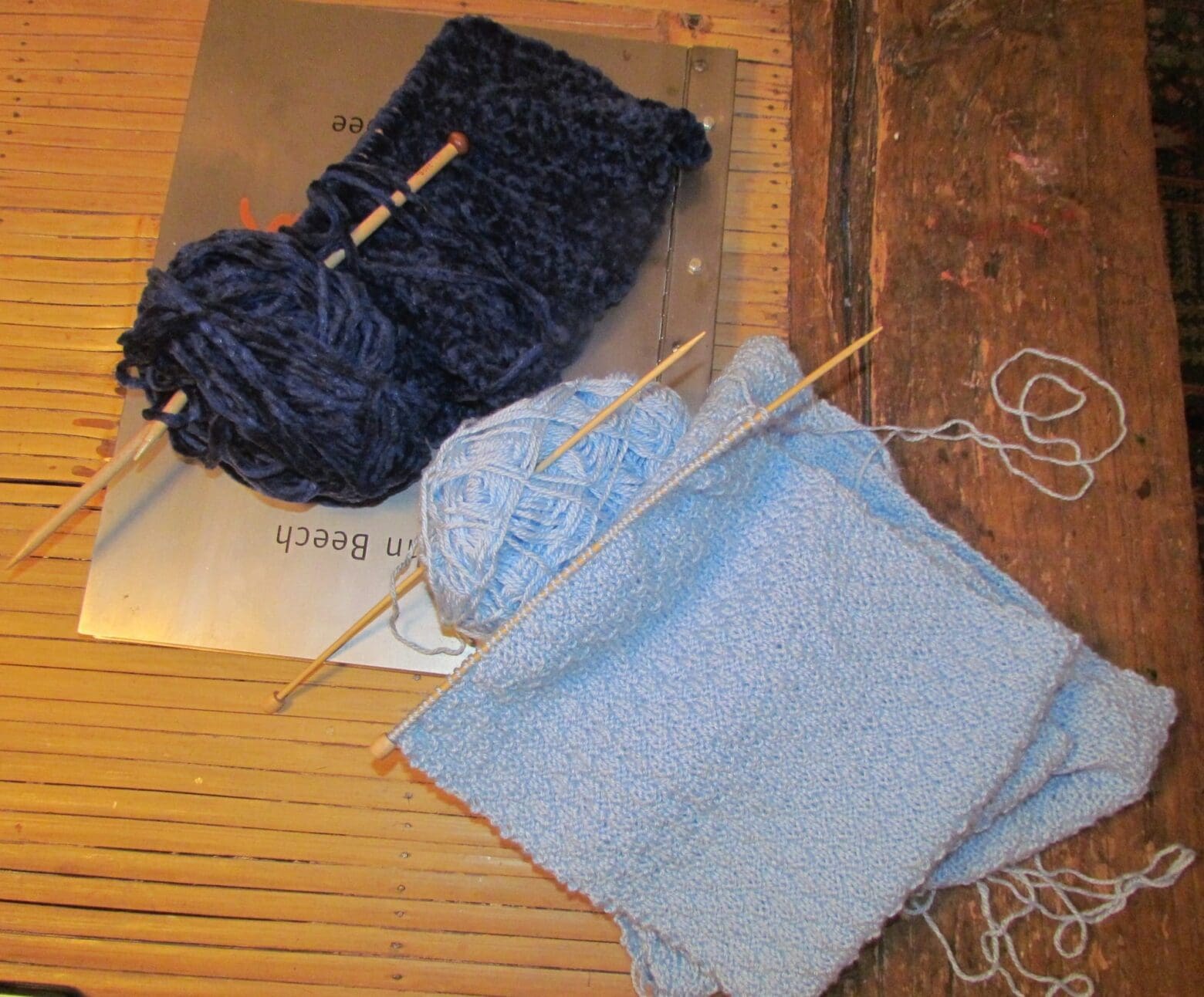


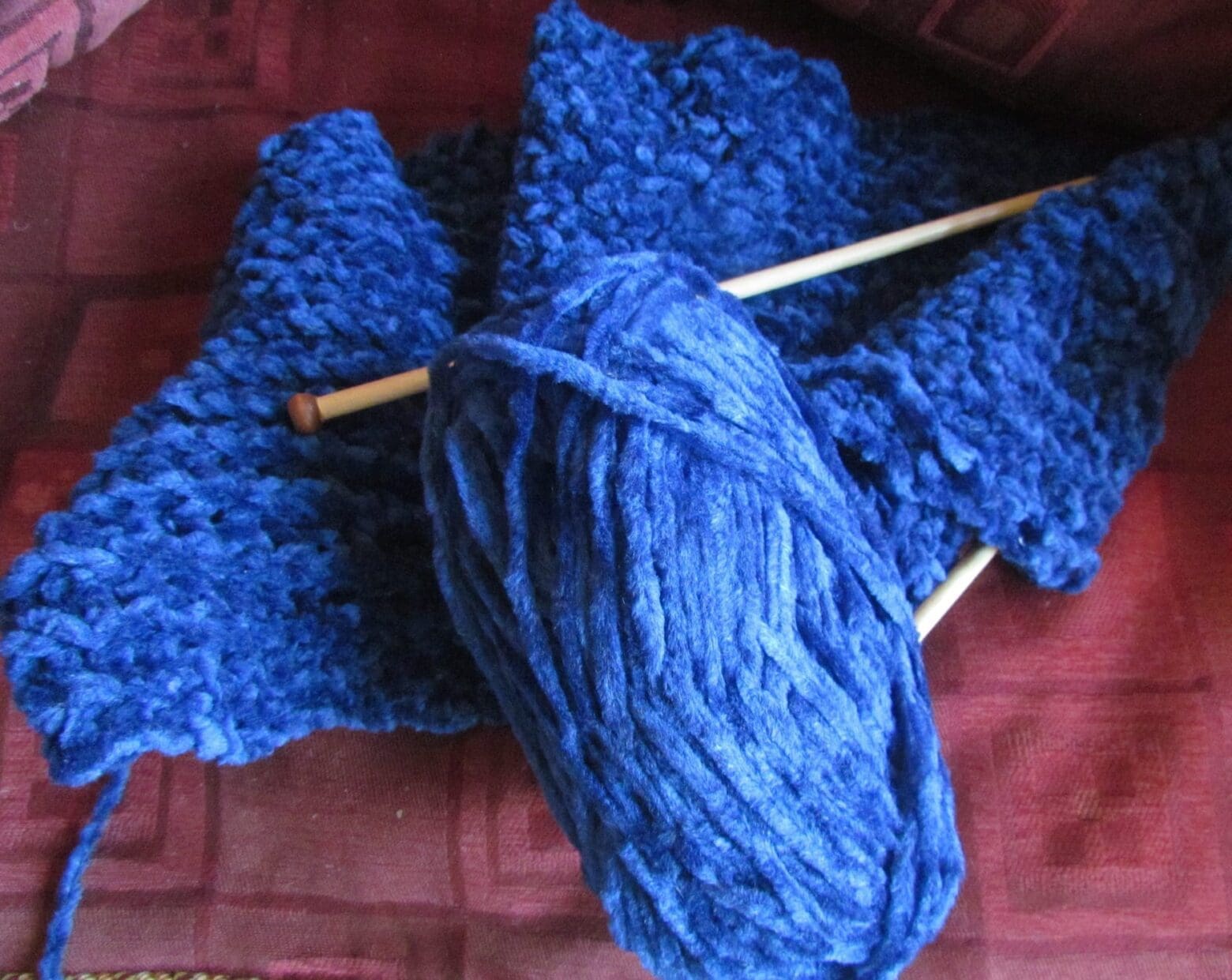

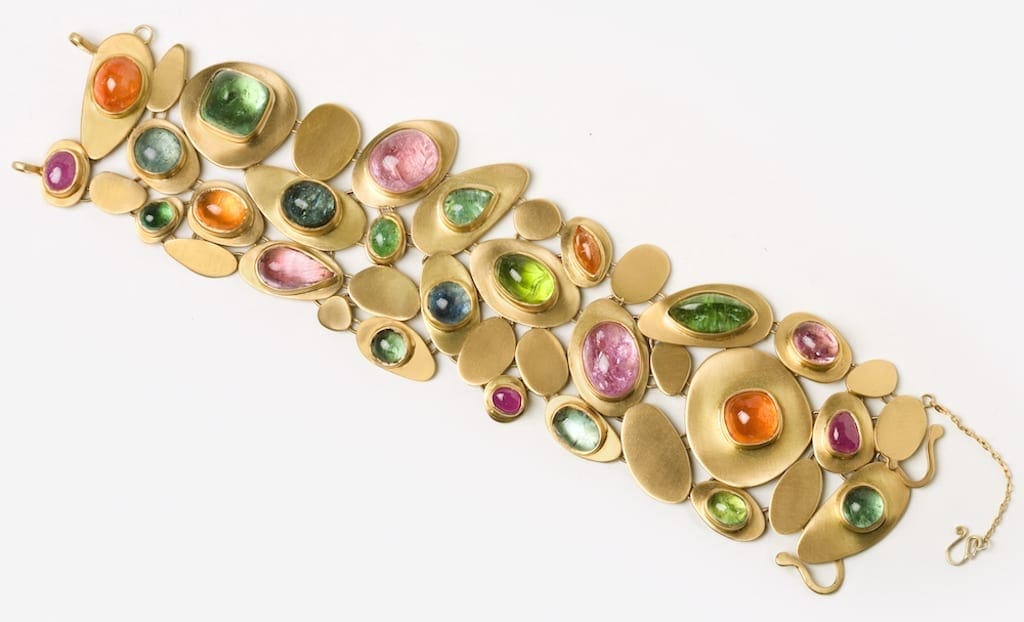
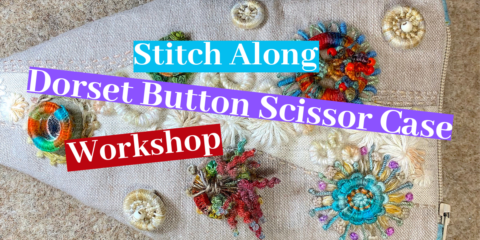
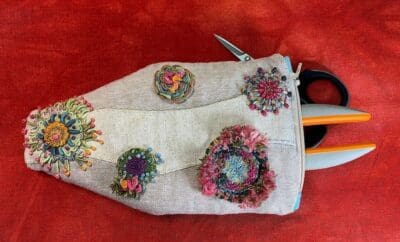
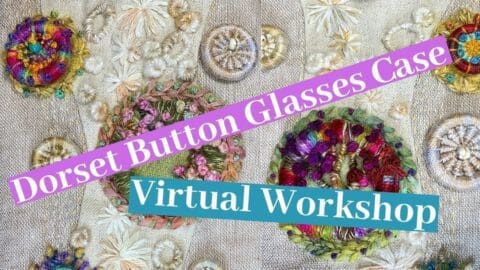
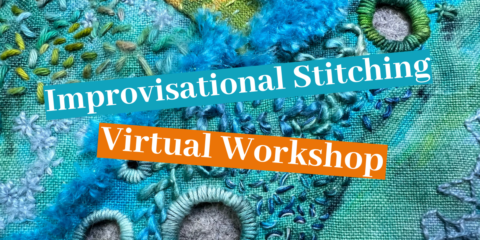
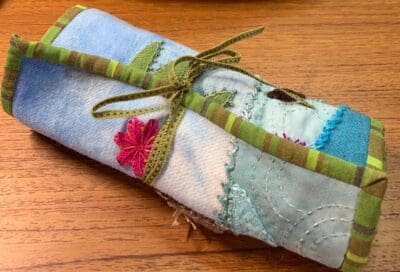
Recent comments